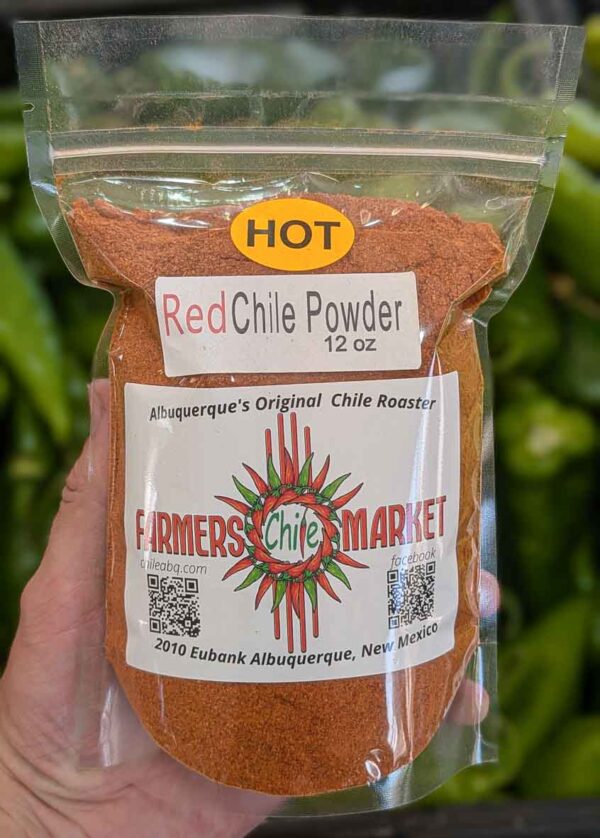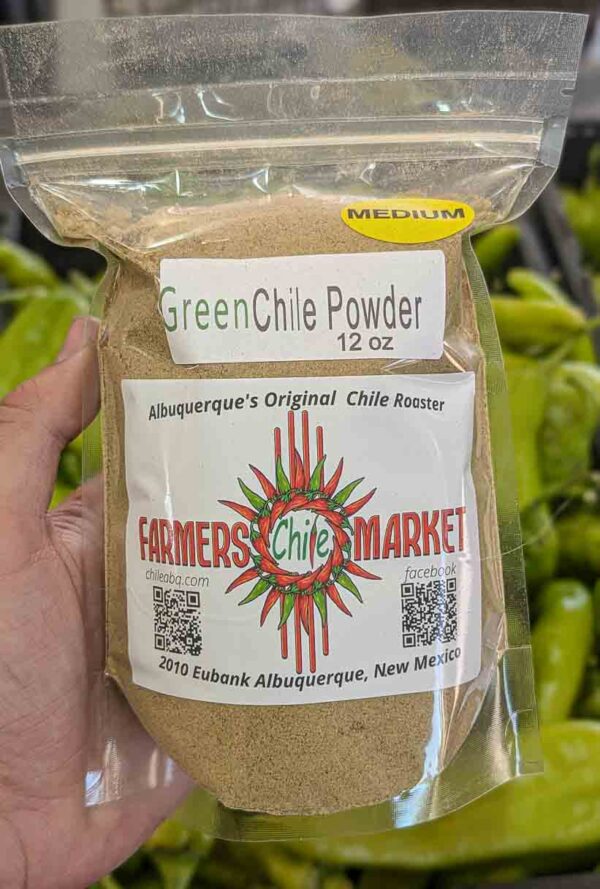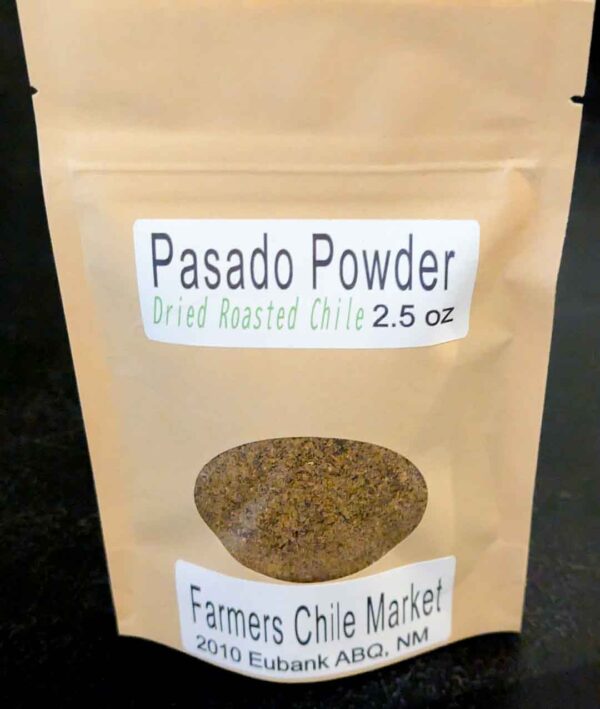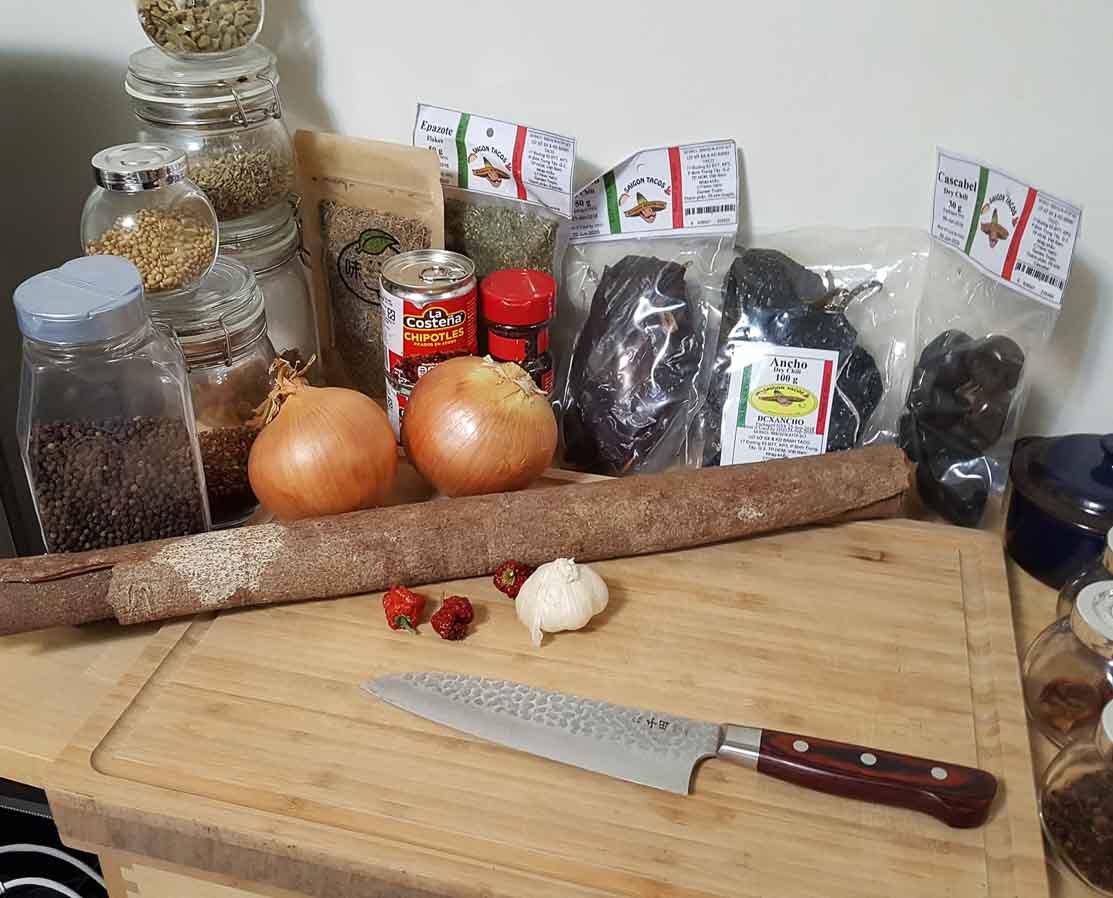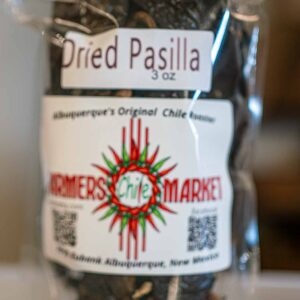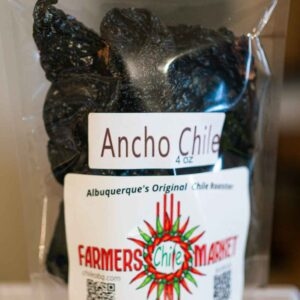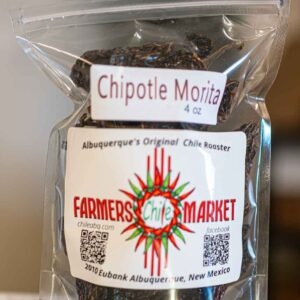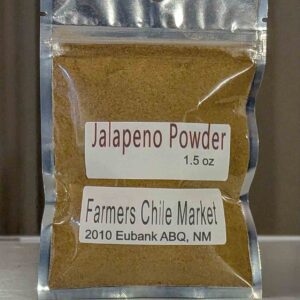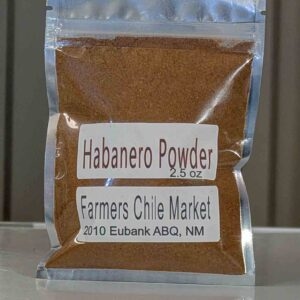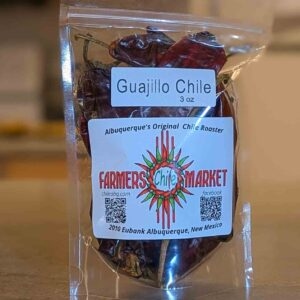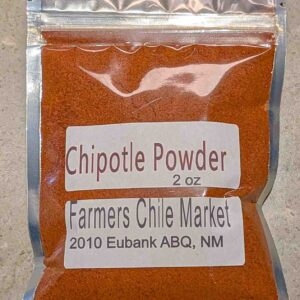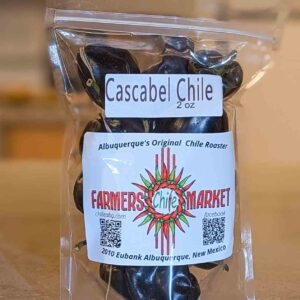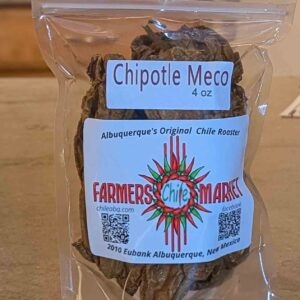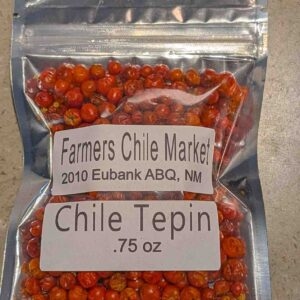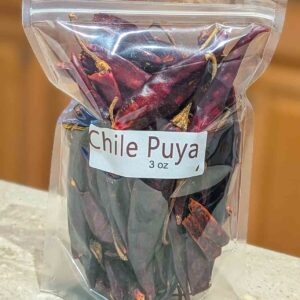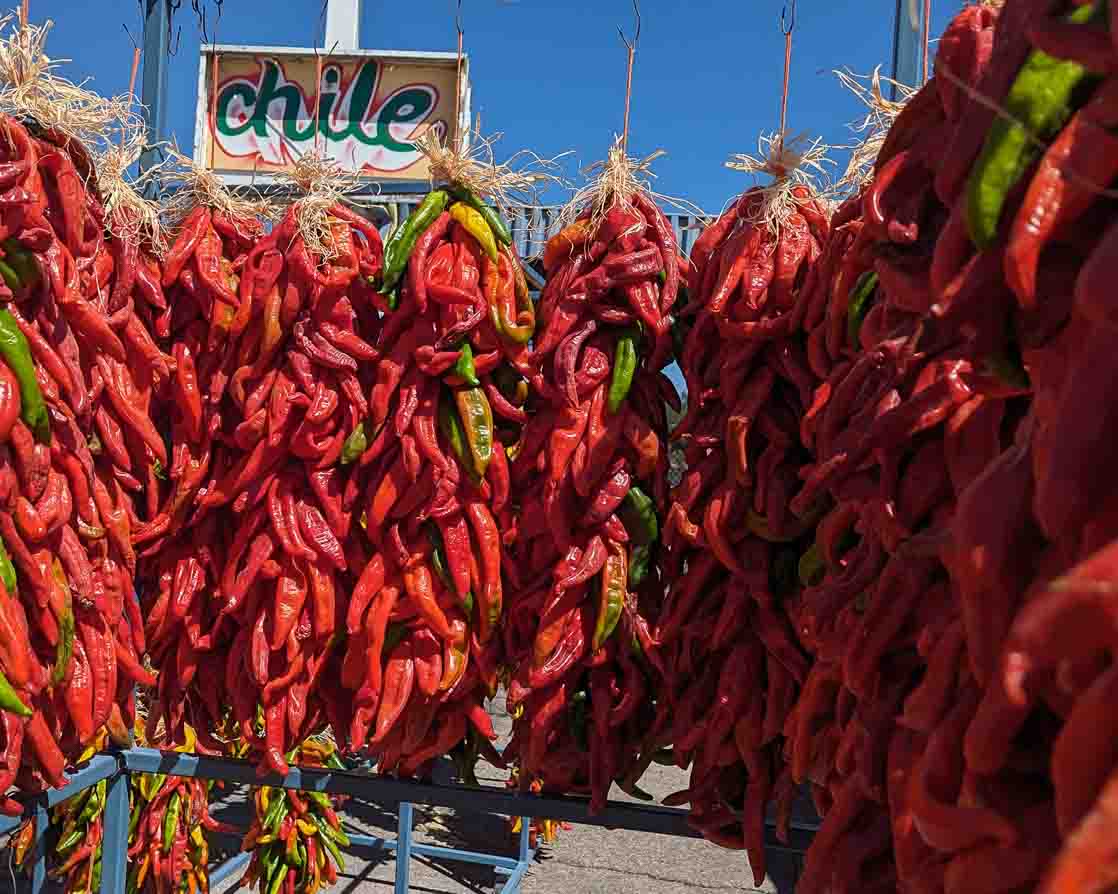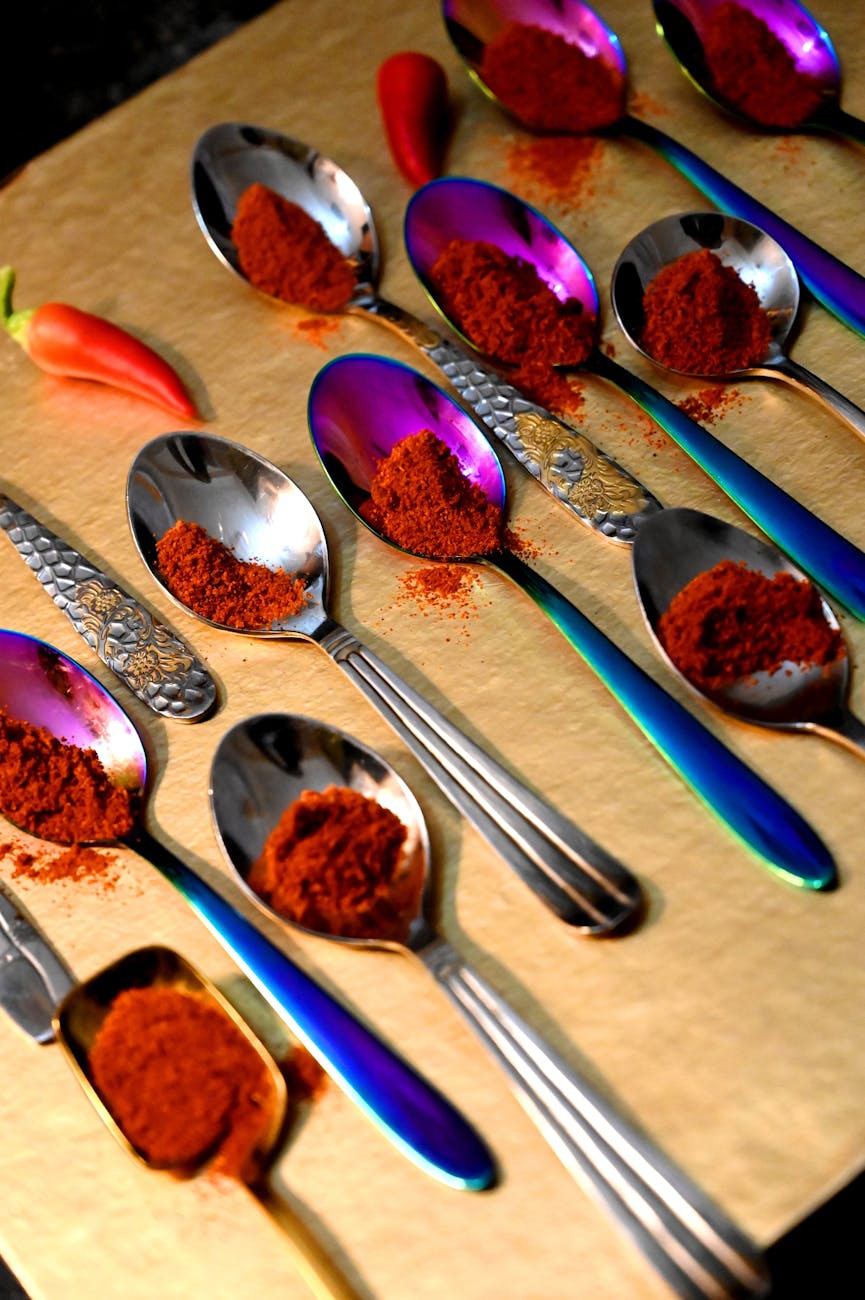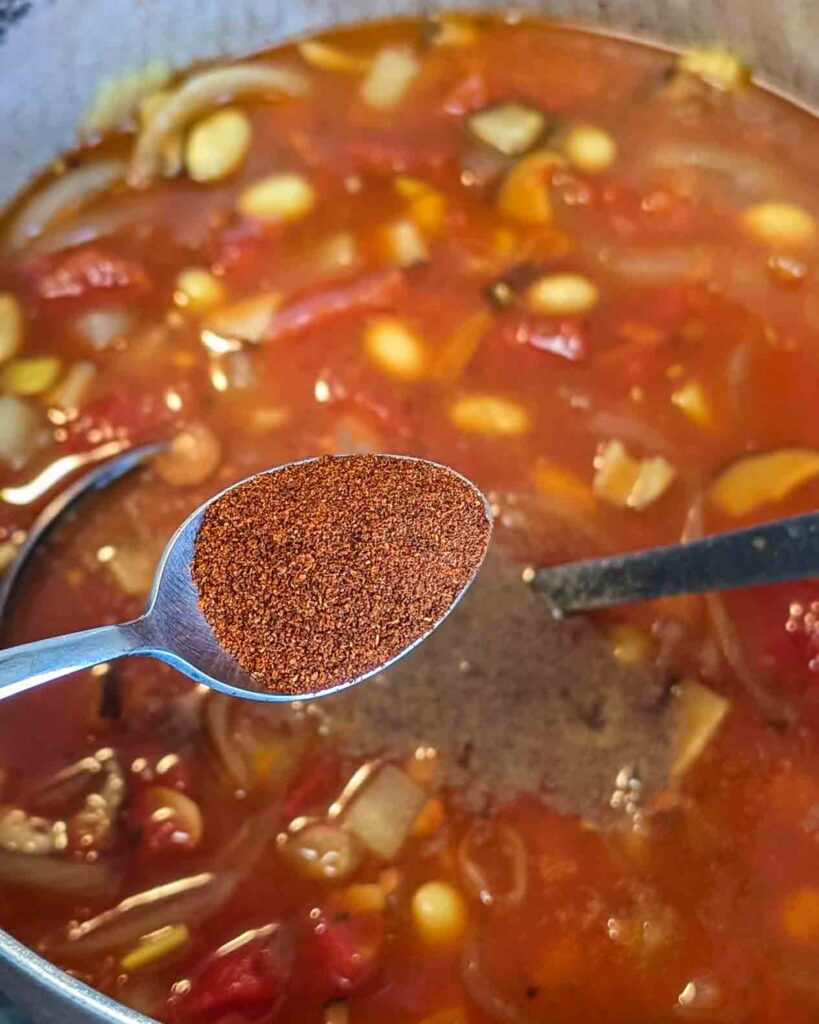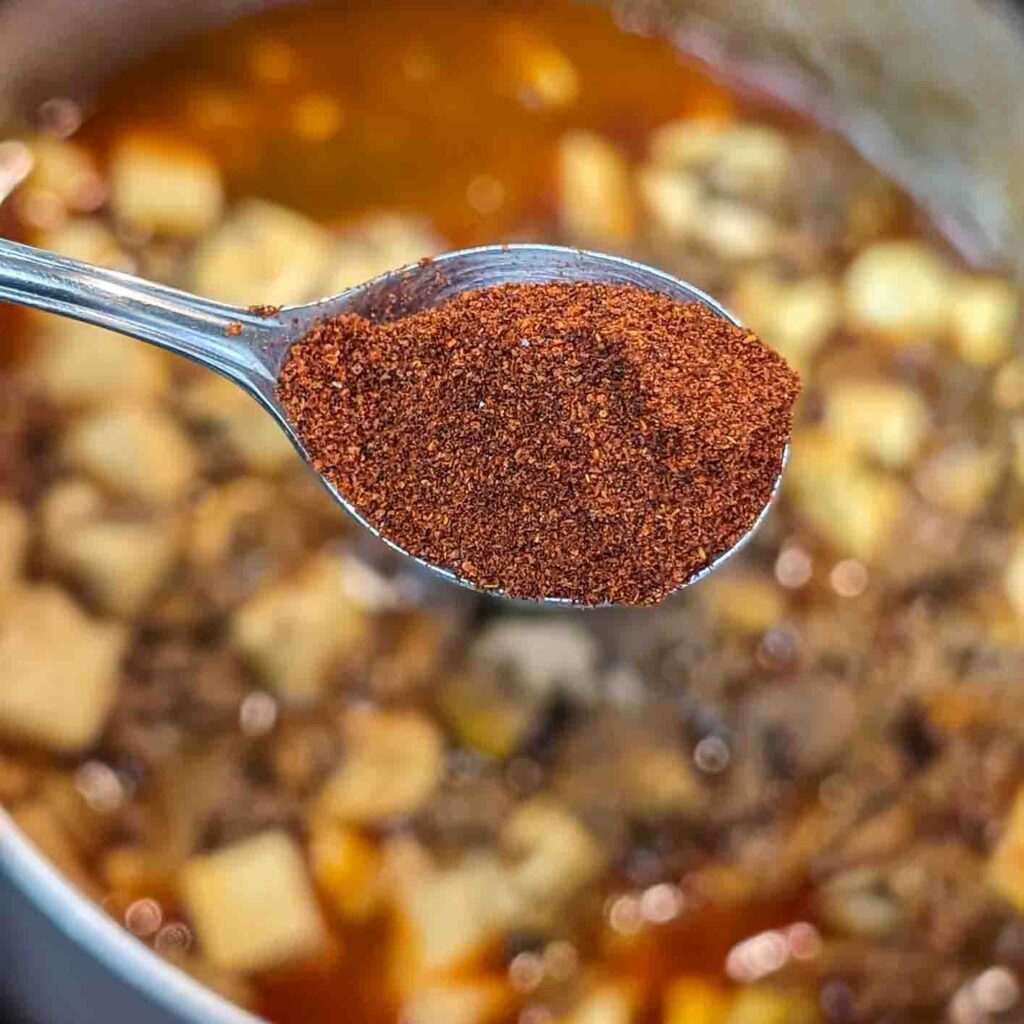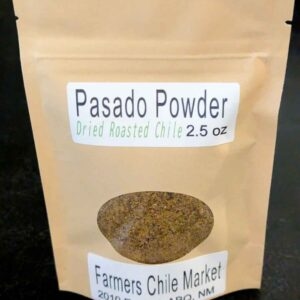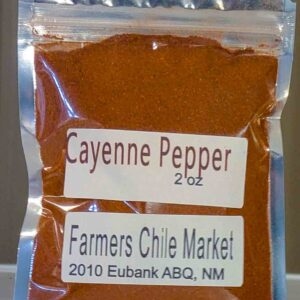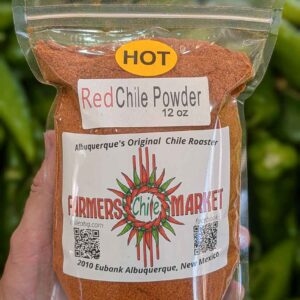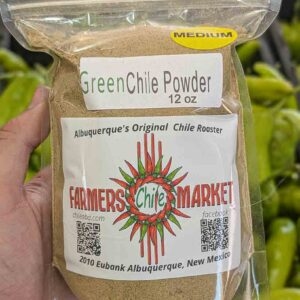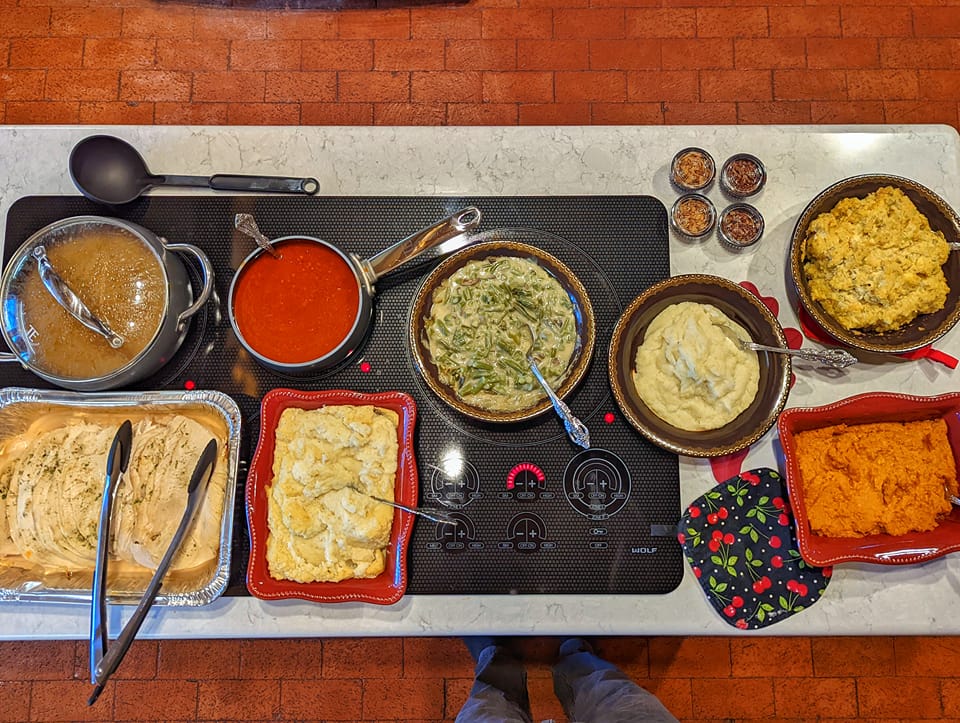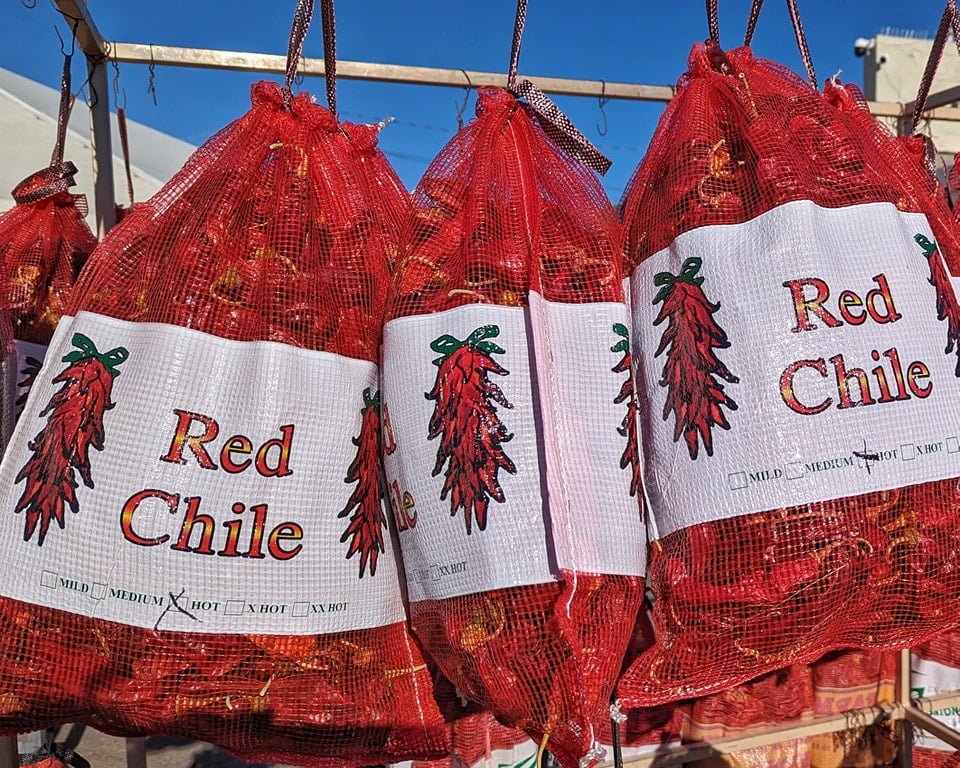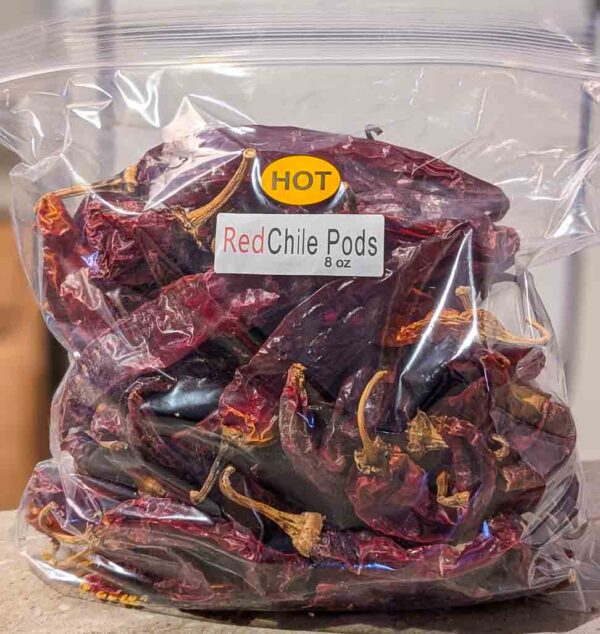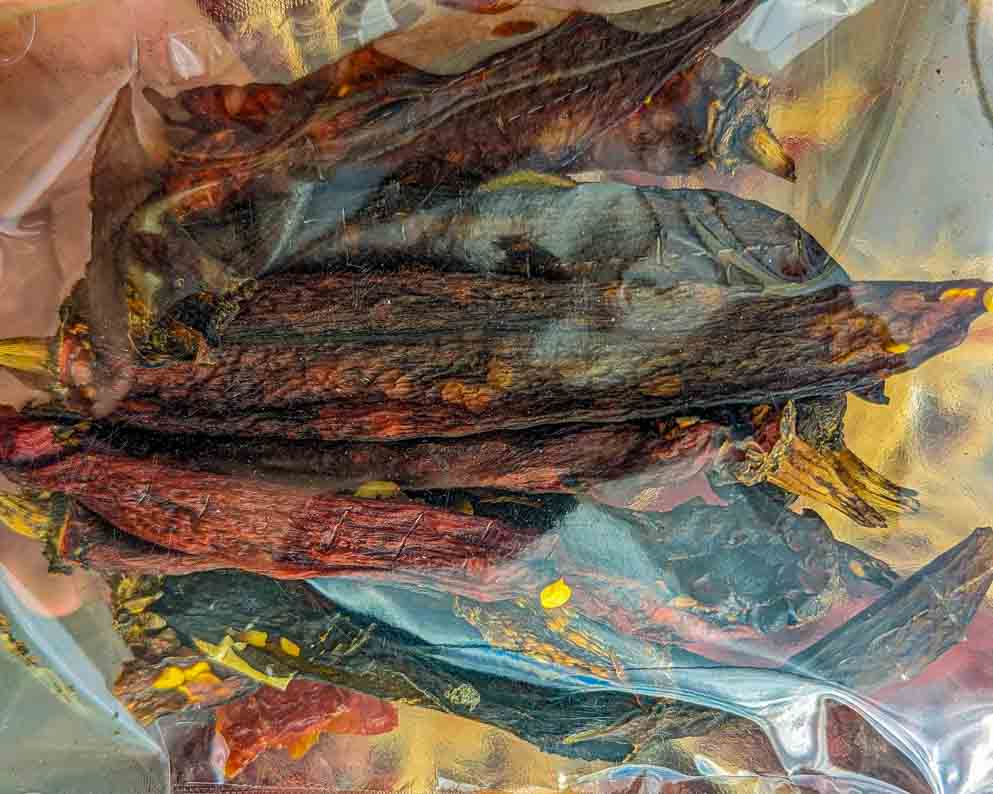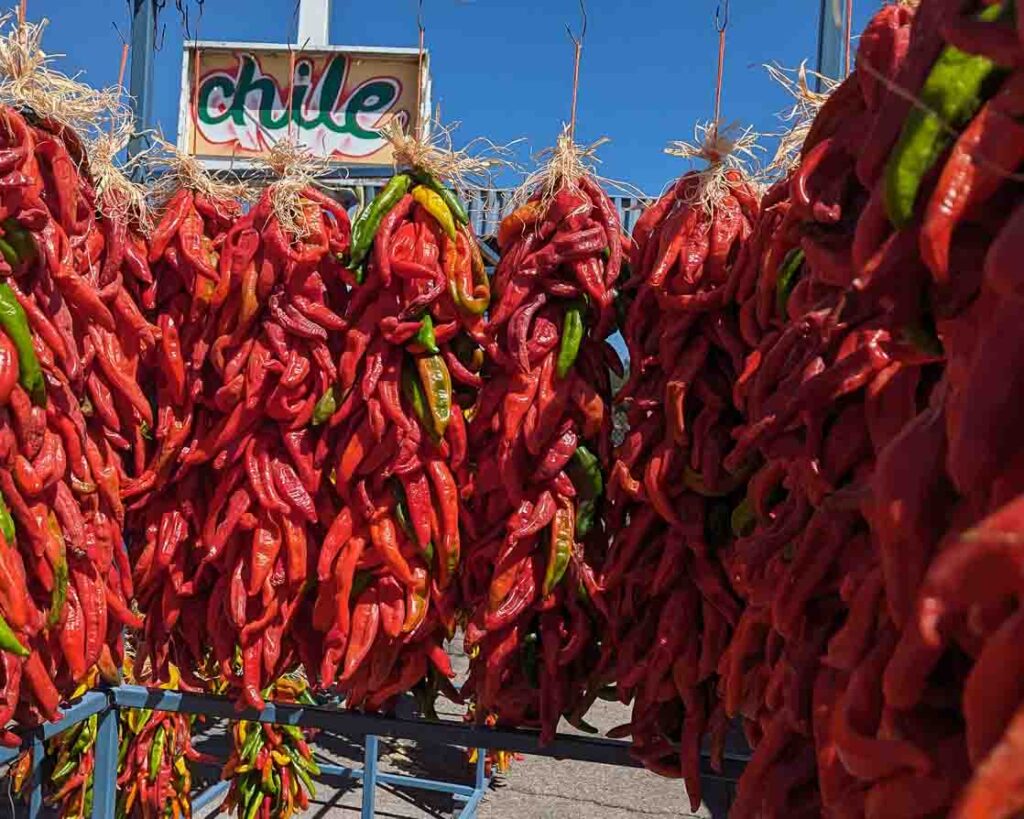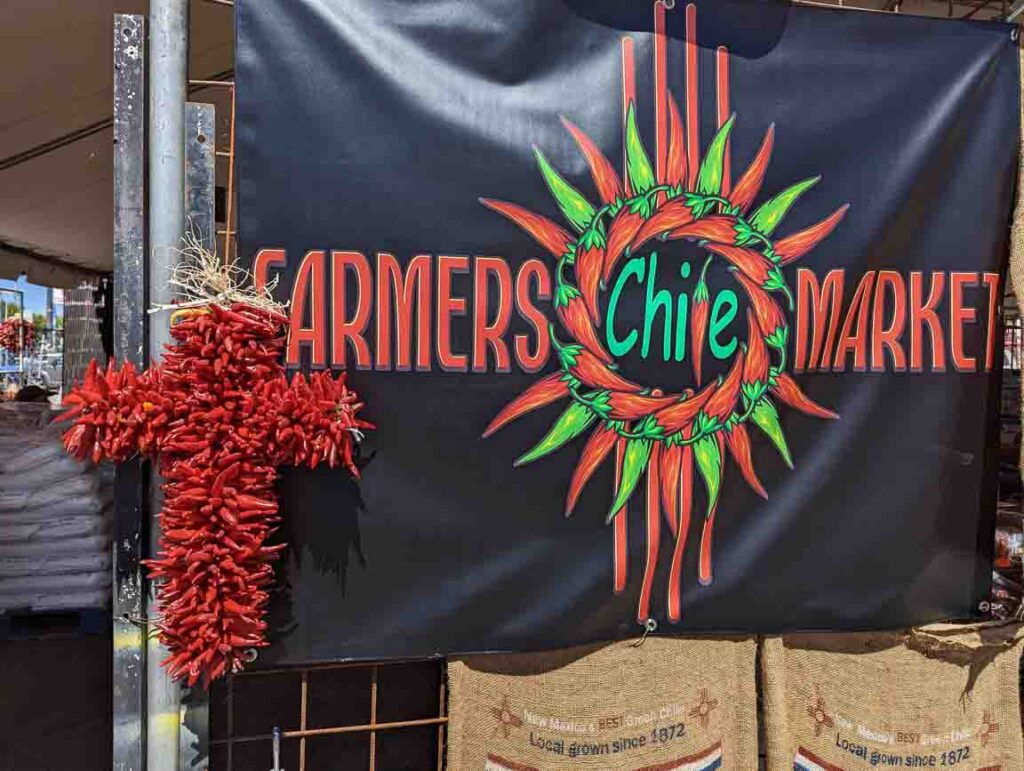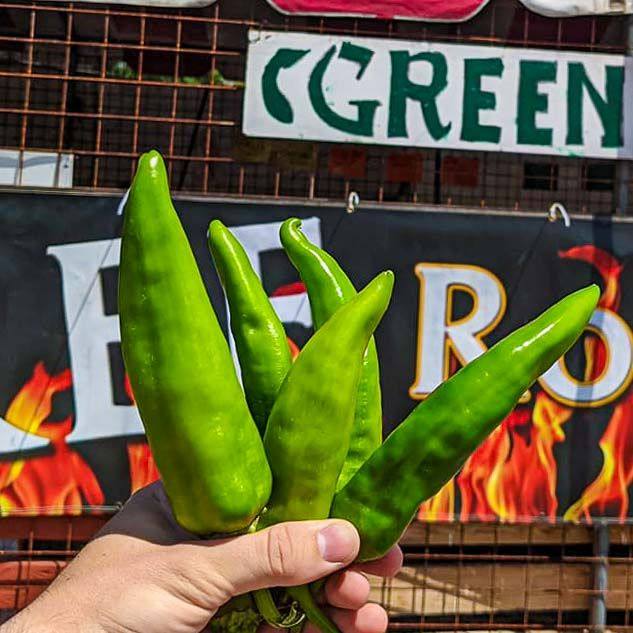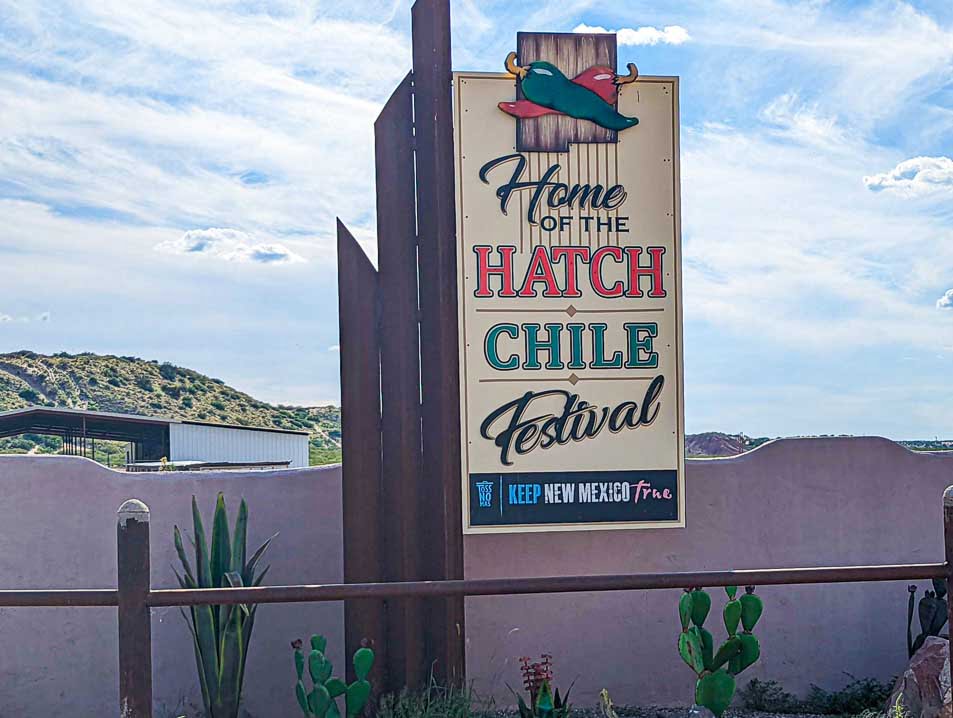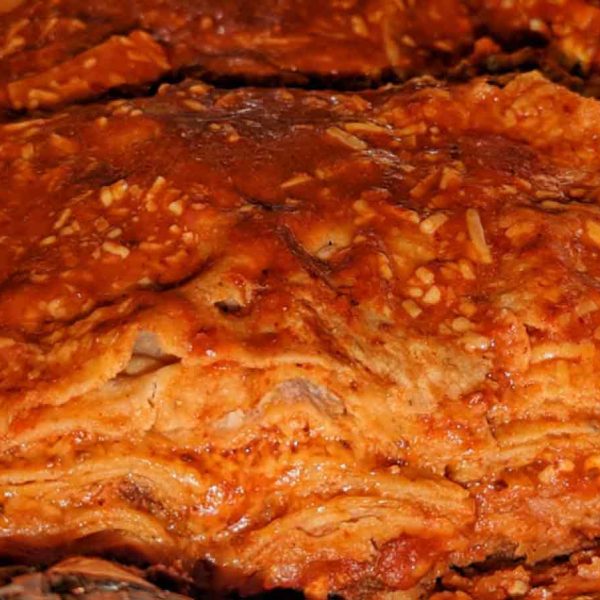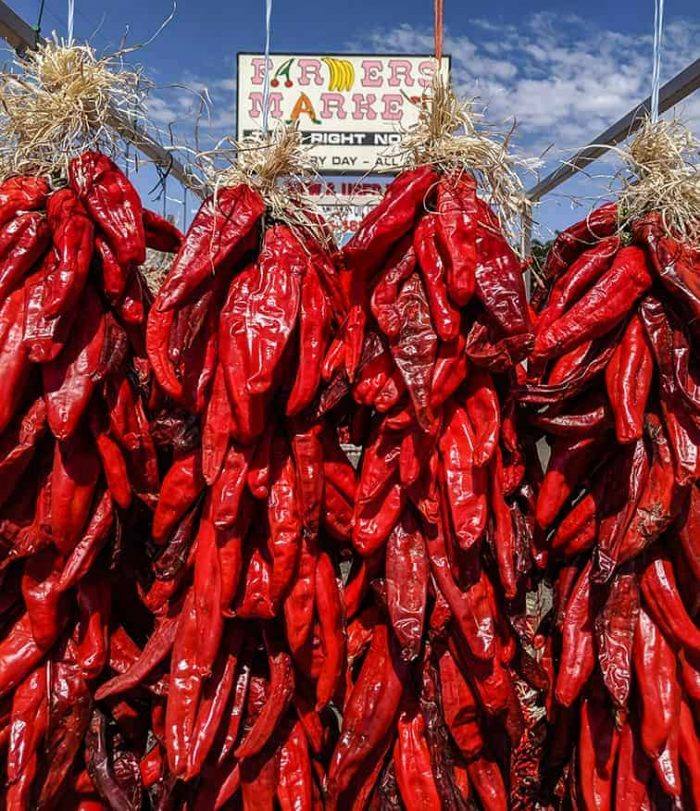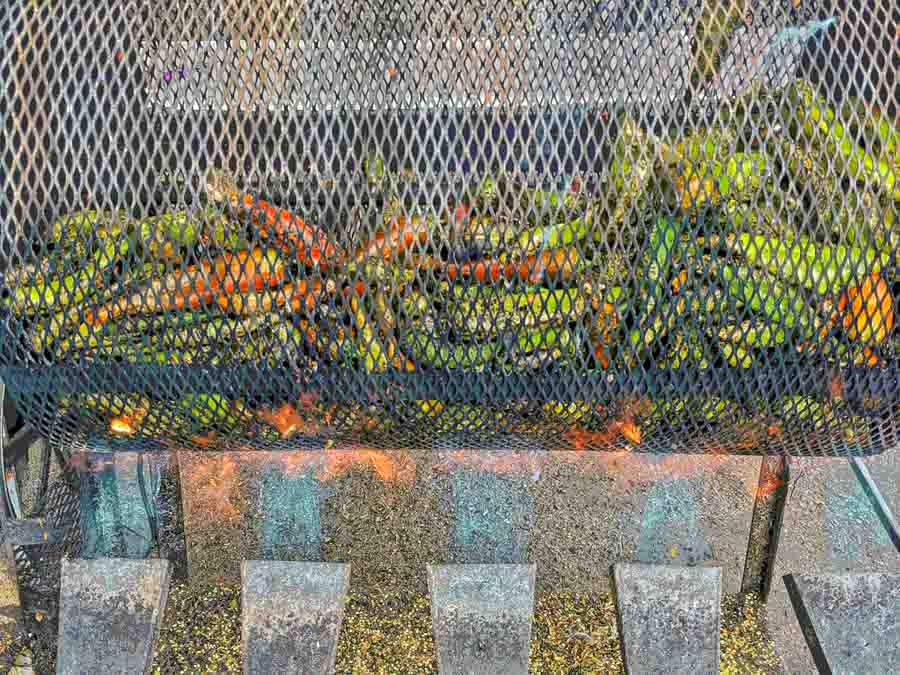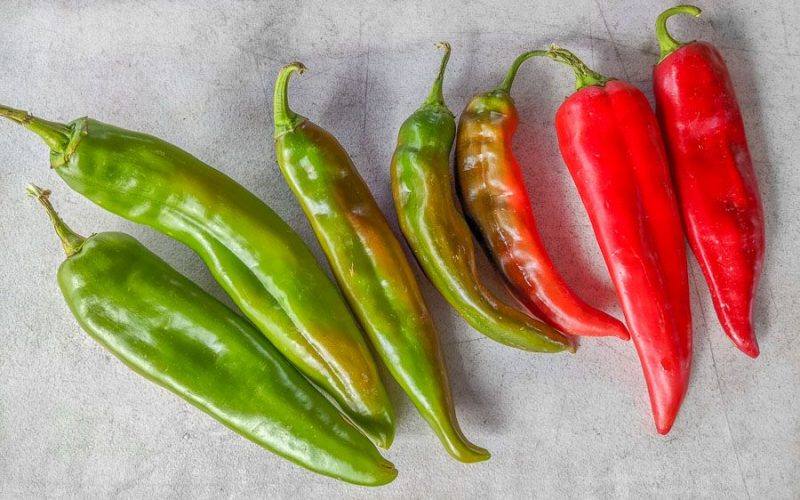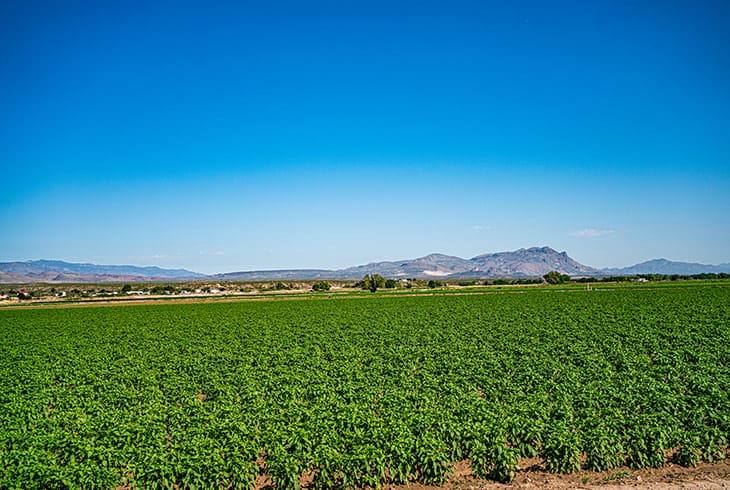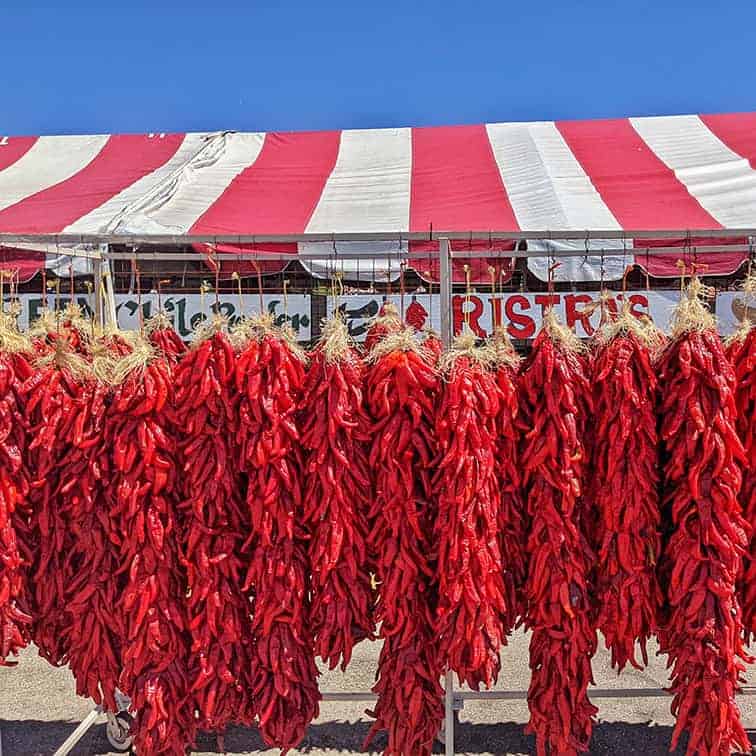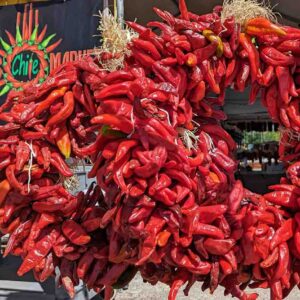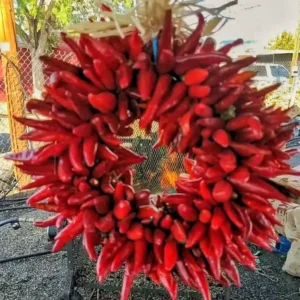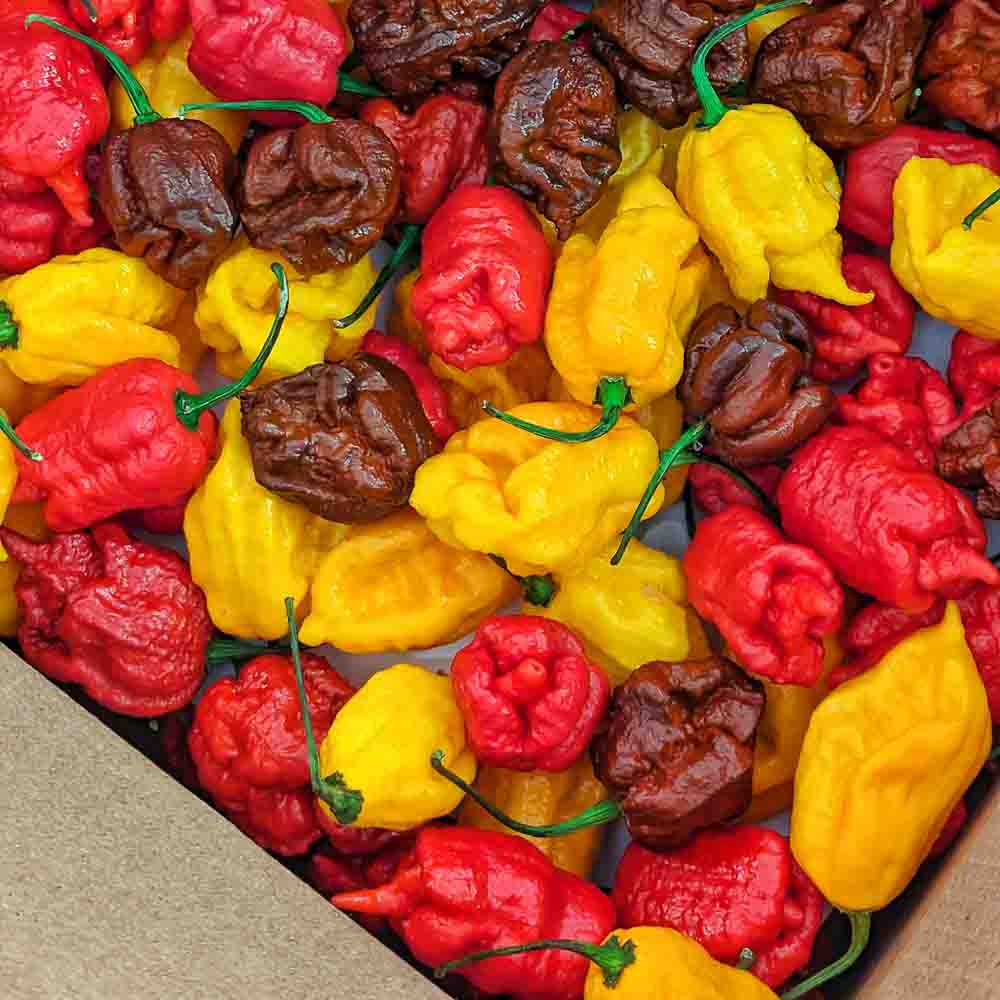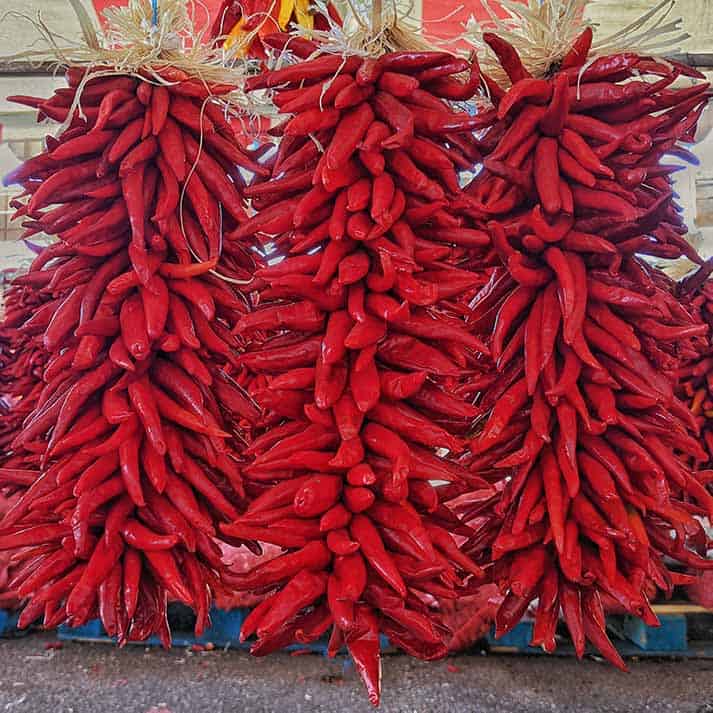Your cart is currently empty!
Category: dried chile
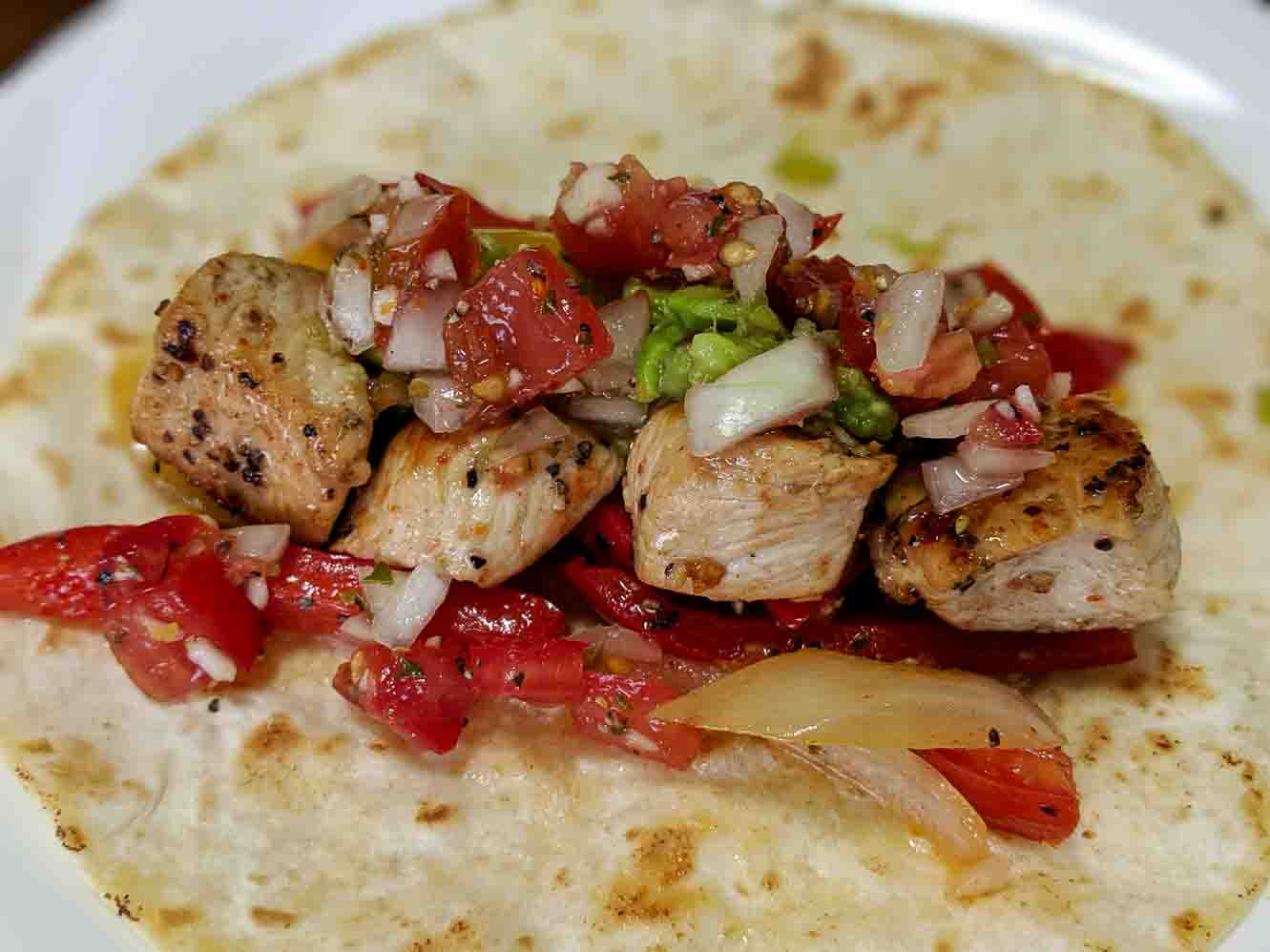
Best Chili Powder for Tacos
In case you’ve landed on this page, odds are that you love some tacos! Well, in New Mexico, we love tacos too! If you can get a type of taco in Los Angeles or Mexico City, odds are you can also get an authentic version in Albuquerque or Las Cruces too! One thing that makes New Mexican tacos unique is that most people will use flame roasted green chile in them. In Mexico, spice lovers will often eat a flattop roasted jalapeno or serrano pepper alongside tacos.
Red Chile Powder in Tacos
A fundamental part of New Mexico kitchens is the bag of Hatch red chile powder that goes into most recipes to add a little spice to many different recipes. This powder typically comes in 5 different heat levels, ranging from mild all the way to XXX-Hot! Many pantries will have a couple different heat levels in order to satisfy eaters with varying tolerances to spice. Personally, I have about 20 different heat levels in my pantry, but most people don’t run a chile store like me! Red chile powder is a fundamental spice here, along with garlic and onion powder. If you get a taco made by a New Mexican cook, odds are they put red chile, onion, and garlic powder into their seasoning for whatever dish.
Using Hatch Red Chile Powder in Tacos
Get the right spice level
First, ensure that you have the right spice level for you and your family. This takes a little trial and error, as the Mild to XXX-hot scale is somewhat subjective. If you are the kind of person who eats hot sauces with demons or tombstones on it, even XXX-hot Hatch chile powder will be light for you. In that case, consider Habanero Powder. For reference, Mild powder is typically around 0-500 Scoville, similar to Paprika. Medium is around 1500-3000. Hot is around 5-6000. X-hot is around 8-10,000. XXX-hot lumbre powder is typically around 10-12,000. There are some variances in this, as every season runs slightly different, similar to wine vintages.
How to Use chile powder in Tacos
A great way to do this is include it in your marinade! Take any basic recipe for marinating meats or vegetarian options like tofu or jackfruit and throw in some chile powder. It’s really that simple! In case you prefer seasoning while cooking, I recommend a teaspoon when you turn the heat down and are mixing things around a final time before serving. This prevents the powder from burning and preserves the heat and natural flavor profile of the chile.
New Mexican Flavor
I should point out that using chile powder extensively is more of a New Mexican thing than a Old Mexican thing. Of course people in Mexico also use various chile powders, the extent of its availability is less than in New Mexico, and it also has different regional variations that aren’t found everywhere. In New Mexico, 90% of households will use chile powder in their cooking, primarily from Hatch, but sometimes also chile from Chimayo, or wherever their local chile grower is from. There are small farms supplying towns all throughout New Mexico, and often they also have chile powder from the prior season available.
More Ways to use Hatch Chile Powder
I love using Hatch chile powder in many different recipes, not just tacos! Chile powder is a great way to add spice and flavor to many different recipes! I have another post about using chile powder that goes over some of the ways I use it! There are many ways to incorporate New Mexican flavor into your food, even in international foods!
So What’s the best Chile Powder?
Maybe I’m biased, but I think it’s New Mexico chile powder. The versatility is unmatched, and it is hard to get a chile powder with the variety of heat levels as Hatch chile powder. The most common types of chili powder used are paprika powder and cayenne pepper. Paprika has pretty much no heat, and cayenne is significantly hotter than even XXX-Hot NM chile powder. This means you can use more New Mexico chile powder for flavor without ramping up the spice too much. If you like spicy flavors, just add more powder. It’s really that simple. The chile powder flavor won’t overwhelm your recipe, because it tastes nice to begin with.
chile powder for sale online
Below I have both red and green chile powder options for purchase! Thanks for making us your favorite spot to order chile powder online!
Hatch Red Chile Powder
$8.99 – $50.00Hatch Green Chile Powder
$9.99 – $55.00Roasted Hatch Green Chile Powder
In case you are interested in trying a relatively new type of chile powder, we also have chile pasado powder for sale! Chile pasado is roasted and dried New Mexico chile. It has a smokey spicy flavor profile, and goes great on tacos among other things. It has been my go to chile powder when I want the essence of roasted green chile without having to deal with peeling and chopping it!

Mexican Chile at Farmers Chile Market
In New Mexico, although there is a prevalence of chile available from Mexico, the vast majority of people primarily eat local chile, whether it is Hatch chile, Socorro Valley chile, or northern New Mexico chile like Espanola Improved or Chimayo chile. Other than this, jalapeno is another very common chile eaten by New Mexicans, and a pickled jalapeno goes great with fried chicken, as many loyal Golden Pride customers in Albuquerque will tell you!
We still have lots of Mexican Chile!
As we are a border state, we have many people from Mexico, whether they are first generation immigrants or their family has been here for centuries. Because of this, we also have a lot of variety of more traditional Mexican foods available too! There are many types of chile peppers commonly used here such as pasilla, ancho, and chipotle. Guajillo is a chile not terribly commonly used because our red chile pods are such a great substitute, and have a better flavor and selection of heat level in my opinion.
Mexican Chile For Sale
We sell all of these varieties on our store during the chile season, but we sell online year round, barring some occasional vacations.
-
 Pasilla Chile – 3 oz$4.99
Pasilla Chile – 3 oz$4.99 -
 Ancho Chile – 4oz bag$4.99
Ancho Chile – 4oz bag$4.99 -
 Chipotle Morita$5.45
Chipotle Morita$5.45 -
 Jalapeno Powder$3.99
Jalapeno Powder$3.99 -
 Habanero Powder$4.95
Habanero Powder$4.95 -
 Guajillo Chile$4.89
Guajillo Chile$4.89 -
 Chipotle Powder$3.99
Chipotle Powder$3.99 -
 Cascabel Chile$7.99
Cascabel Chile$7.99 -
 Chipotle Meco$6.99
Chipotle Meco$6.99 -
 Chile Tepin .75 Oz bag$8.88
Chile Tepin .75 Oz bag$8.88 -
 Dried Puya Chile$6.69
Dried Puya Chile$6.69
-

Not Just Pretty Peppers: Why Chile Ristras Are the Perfect New Mexico Gift
New Mexico’s vibrant culture, dramatic landscapes, and fiery cuisine all leave a lasting impression on visitors. But when it comes to picking the perfect souvenir, what truly captures the essence of the “Land of Enchantment” and offers year-round enjoyment? Look no further than the humble chile ristra.
A Tradition Steeped in History and Practicality
Ristras are more than just decorative strings of peppers; they’re a time-honored tradition with deep roots in New Mexican history. Originally, they served a practical purpose. Farmers would string chile peppers together after harvest, allowing them to dry naturally in the warm New Mexico sun. This ingenious technique not only preserved the precious crop for winter use but also added a festive touch to adobe homes, symbolizing a successful growing season and the promise of flavorful meals to come. An added benefit is that it protects the chile from birds, who love to eat chile seeds.
A Gift for Every Occasion: From Birthday Cheer to Wedding Wishes
The beauty and versatility of chile ristras make them a fantastic New Mexican gift for any occasion.
Birthdays and Anniversaries:
A vibrantly colored ristra in a festive length adds a unique touch to a gift basket. For a standalone gift, a ristra can symbolize warmth and passion, perfect for celebrating another year with a loved one.
Weddings:
Miniature ristras or artistically crafted chile wreaths make delightful favors for guests, adding a touch of New Mexican flair to the celebration. For the happy couple, a larger ristra hung above the doorway serves as a lucky charm, a fiery symbol of abundance and good fortune in their new life together.
Thinking of You or Get Well Wishes:
A brightly colored ristra with a basket of New Mexican treats is a thoughtful way to send warm wishes to someone far away or recovering from an illness. The vibrant colors and promise of future enjoyment can offer a much-needed pick-me-up.
A simple southwest souvenir:
In case you visit New Mexico, a chile ristra is a great thing to take back with you to remember your visit to the Land of Enchantment. It’s also a great thing to give as a present on your return home. The best part is that chile ristras are edible, and can make an amazing red chile sauce, just take chile off the bottom of the ristra and tuck the string back up to hide it. Be sure to check out our guide to making a red chile sauce for inspiration of how to use your ristra and bring you back to the flavors of New Mexico!
A housewarming present
A chile ristra is a great home decoration, and is a fantastic way to welcome someone into a new home. The ristra can be an exclamation point on the new phase of life someone enters when they move. More than just that, it can add a touch of spice to their cuisine for years to come!
A Gift That Goes Beyond Decoration: The Culinary Connection
Not all ristras are created equal. Look for untreated ristras if the recipient enjoys cooking. These beauties can be rehydrated and used to create everything from fiery salsas to rich stews, bringing the authentic flavors of New Mexico straight to their kitchen. For those who prefer a decorative option, treated ristras maintain their vibrant color for years, adding a touch of the Southwest to any kitchen or living space. At Farmers Chile Market, we are a simple food store, and do not treat ristras. There are many guides online to treat ristras, and it can be done with laquer, shellac, hairspray, clear acrylic spraypaint, or even melted beeswax! Just be sure the ristra is completely dry before treating it, as residual wetness inside of the chile will mold and cause the ristra to decay if it is not fully dry before treatment.
Gifting a Piece of New Mexico: More Than Just Chiles
Whether you choose a decorative or culinary ristra, you’re gifting more than just peppers. You’re giving a piece of New Mexican tradition, a symbol of resilience and resourcefulness that has been passed down through generations. Ristras represent the state’s warm hospitality and vibrant spirit. So next time you’re searching for the perfect gift, consider the humble chile ristra. It’s a gift that’s both beautiful and practical, a taste of New Mexico that will be cherished for years to come.
Beyond the Gift: Exploring the World of Ristras
For the chile aficionado on your list, consider pairing a ristra with additional New Mexican treats. A bag of red or green chile powder allows them to experiment with the state’s signature flavors in their own kitchen. Gourmets will appreciate a jar of local honey infused with the smoky heat of red or green chile. Chile pasado is a great way of taking the flavor of roasted green chile back with you, to share with friends and family. These additional touches elevate a ristra from a simple gift to a curated culinary experience, allowing the recipient to fully immerse themselves in the unique world of New Mexican cuisine.

Hatch Red Chile Powder
Hatch red chile powder, a vibrant and flavorful product hailing from Hatch, New Mexico, has become a beloved ingredient in kitchens across the country. One of its most significant advantages lies in its sheer practicality. Unlike fresh roasted chile, which require cleaning, roasting, peeling, and sometimes seeding, Hatch red chile powder comes ready to use. The dried red chile pods are already blended up and ready to use! This saves time and effort, especially for busy cooks or those new to working with chiles. Simply measure out the desired amount for a fiery kick or a subtle smoky depth. No more wrestling with stubborn skins or worrying about accidentally including too many seeds and overwhelming the dish with bitterness. Hatch red chile powder delivers consistent flavor and heat every time, making it a reliable tool for achieving culinary success.
This convenience extends to its incredible versatility. Whether you’re crafting a rich and complex red chile sauce for enchiladas or simply want to add a touch of heat and smoky flavor to a dish, Hatch red chile powder shines. Consider a Hatch red chile powder in the same way you might use cayenne chili powder or paprika. In New Mexico, we typically label how spicy it is, so use whatever heat level you think is good for you.
Using Red Chile Powder
For a quick and flavorful red chile sauce, simmer the powder in broth with garlic, onion, and spices. The powder readily hydrates and infuses the broth with its signature chile essence, creating a base for enchiladas, huevos rancheros, or even a comforting bowl of red chile stew. Need a simpler application? Sprinkle Hatch red chile powder into pasta sauces for a touch of heat that complements Italian flavors beautifully, or incorporate it into meat marinades for a smoky depth that elevates the flavor profile. Soups, stews, and even scrambled eggs can benefit from a pinch of Hatch red chile powder, the vibrant color adding a visual pop to the dish in addition to the flavor boost. For the adventurous cook, consider incorporating it into chocolate desserts like mole or even smoky cocktails for a surprising and delightful twist. The possibilities are truly endless, limited only by your imagination.
Making a Red Chile Sauce from powder
Although many purists will say you shouldn’t use flour, or a chile sauce should only be made fresh from red chile pods, sometimes powder is all you have to work with. In that case, give this recipe a whirl, and see how easy it is to make a quick red chile sauce with powder!
Ingredients:
- 1/2 cup red chile powder (choose your heat level based on your family’s tolerance)
- 2 tsp vegetable oil or lard for a richer flavor
- 3 to 4 tbsp onion, finely chopped (increasing the amount adds more flavor)
- 2-3 cloves garlic, peeled & finely chopped
- 1 tsp dried oregano(Some people don’t like this)
- 1 tsp ground cumin(Some people also don’t like this)
- 2 tsp all-purpose flour
- 2 1/2 cups water, broth, or stock for extra depth
- 1/2 to 1 tsp salt, or to taste
Instructions:
- Make a roux: In a 2-quart saucepan, heat the oil over medium heat. Add the chopped onion and garlic, and sauté until softened and fragrant, about 5-7 minutes.
- Bloom spices: Stir in the oregano and cumin, and cook for about 30 seconds until fragrant. (this is optional, do it if you like oregano and cumin!)
- Thicken with roux: Sprinkle in the flour and stir constantly for 2-3 minutes until the mixture forms a roux and turns a light golden brown.
- Temper the chile: In a separate bowl, whisk together the chile powder and water until smooth, making sure there are no lumps.
- Combine and simmer: Gradually whisk the chile mixture into the roux in the saucepan. Bring the sauce to a gentle simmer, stirring constantly to prevent scorching.
- Cook and thicken: Reduce heat to low, cover, and simmer for 10-15 minutes, stirring occasionally. The sauce should thicken slightly and become more flavorful as it cooks.
- Season and serve: Remove from heat and season with salt to taste. Let the sauce cool slightly to thicken further before serving.
Green Chile Powder: A Different Kind of Heat
While Hatch red chile powder reigns supreme, green chile powder exists as a lesser-known counterpart. Green chile powder is typically machine dried, a process that keeps the green chile a bright color. Due to the high speed of drying, the sugars don’t naturally ferment, and the sugar in machine dried chile remains. This sweetness makes it a good choice for those who enjoy a more nuanced heat experience. Green chile powder is also a relatively new product, gaining popularity alongside the surge in interest in Hatch chile in the US in recent years. Finding it might be slightly more challenging compared to the ubiquitous red chile powder, but its unique flavor profile is worth seeking out for those who appreciate a touch of sweetness alongside the heat.
Making a green chile sauce from powder
You can use the same guide as above to make a green sauce, just use green chile powder instead of red. I recommend adding chopped roasted green chile to this sauce to make it a more full flavor experience, but this sauce is really nice and adds a nice color to drizzle on top of food. It’s great for food photography!
A Hatch Chile Haven: The Farmers Chile Market
If you’re looking to experience the authentic taste of Hatch chiles, head over to Farmers Chile Market at 2010 Eubank Blvd, NE in Albuquerque during chile season, which runs the months of August, September, and October. This haven for chile enthusiasts offers a wide variety of Hatch chile products, including both red and green chile powder in various heat levels. From mild to xxx-hot and superhot chili powder, you’ll find the perfect powder to suit your spice preferences. Whether you’re a seasoned chile aficionado or just starting to explore the world of New Mexican cuisine, Farmers Chile Market at 2010 Eubank Blvd NE in Albuquerque is a must-visit. Beyond the selection of chile powders, you’ll also find fresh roasted chiles, salsas, ristras and other chile-infused treats, making it a one-stop shop for all things Hatch chile.

In case you like a more spicy chile relleno, try mixing x-hot chile powder with the cheese filling! A Culinary Adventure Awaits
To sum up, chile powder provides a lot of value in the kitchen. It eliminates the prep work associated with using whole chile pods, while unlocking a world of culinary possibilities. From classic New Mexican dishes to unexpected flavor twists in familiar recipes, Hatch red or green chile powder can elevate your cooking and take your taste buds on a delicious adventure with every bite. So next time you’re at the grocery store, don’t hesitate to reach for this vibrant ingredient and embark on a culinary journey to the heart of the Southwest. Better yet, visit a chile roaster such as Farmers Chile Market! You might just discover your new favorite way to add heat and depth to your dishes.

Minestrone is my favorite way of clearing out the refrigerator, and a spoonful of red chile powder is an awesome way to improve the flavor! The ideal Fusion Ingredient
I travel a lot, and I also cook a lot. You can learn a bit more about me and places I’ve been in the about me page I wrote. When I travel, I always am sure to bring at least a bag of hot red chile powder made with Sandia chile with me. A spoonful of this powder is the perfect amount of spice, whether I’m making a pasta sauce, a Mapo Tofu, or a butter chicken curry. Not just that, but the depth of flavor an all natural sun dried New Mexico chile powder provides is second to none. A lot of mass market chili powders use machine drying, which doesn’t give the chile a natural aging process to really refine the flavor. This is one of many reasons why I prefer using Hatch red chile powder over alternates like paprika, cayenne, or something else.
The only other chili powder I would consider might be a superhot powder like ghost or reaper powder, but only if I was trying to cook something the hottest flavor possible. I don’t really do that anymore though. I’m getting older, and don’t need to challenge myself like that anymore. For me, a classic Hot red chile powder is ideal, with extra-hot being my next go to spice. If I want a pure red chile sauce, I make it from pods. If I’m cooking something else, you bet I’m reaching for one of my bags of red chile powder.

This hot Hatch red chile powder really leveled up this pot of Mapo Tofu Where to buy Hatch chile powder online?
We sell many different heat levels of both red and green chile powder online. Check below for both of them!
Hatch Red Chile Powder
$8.99 – $50.0012 ounces of Hatch red chile powder grown in the sunny Hatch Valley. This powder is great for use as a spice to kick up the level of your cooking with a little heat, but also can be used to make a whole sauce! I personally use red chile powder in many recipes, like a […]
Hatch Green Chile Powder
$9.99 – $55.00Hatch green chile powder grown in the sunny Hatch Valley. This powder is great for use as a spice to kick up the level of your cooking with a little heat, but also can be used to make a whole sauce! I recommend using it in about the same way you would use a red […]
Other Types of chile powder for sale
We try to keep a wide variety of chile for sale, and you can see for yourself the different types of chile powders we have below!
-
 Roasted Hatch Chile Powder – Chile Pasado Powder$8.99
Roasted Hatch Chile Powder – Chile Pasado Powder$8.99 -
 Cayenne Pepper$3.99
Cayenne Pepper$3.99 -
 Jalapeno Powder$3.99
Jalapeno Powder$3.99 -
 Habanero Powder$4.95
Habanero Powder$4.95 -
 Chipotle Powder$3.99
Chipotle Powder$3.99 -
 Hatch Red Chile Powder$8.99 – $50.00
Hatch Red Chile Powder$8.99 – $50.00 -
 Hatch Green Chile Powder$9.99 – $55.00
Hatch Green Chile Powder$9.99 – $55.00

Red Chile Sauce: A Study in Pure Flavor
The Heart of New Mexican Cuisine
In the Land of Enchantment, red chile sauce reigns supreme. It’s more than just a condiment; it’s a cultural touchstone, a fiery symbol of our state pride. The question “Red or Green?” echoes through New Mexican kitchens, and while we adore our green chile, there’s something undeniably special about the deep, earthy flavor of a well-crafted red chile sauce. Nearly every restaurant boasts its own secret recipe, a testament to the versatility and enduring appeal of this crimson condiment. If you want to make New Mexican food, this is our mother sauce, as important as Béchamel in French cuisine.
Red Chile Sauce Recipe
Ingredients
- 12-15 dried Hatch red chile pods (choose your own heat level)
- 4 cups water or chicken/vegetable stock, warmed
- 4 cloves garlic, minced
- 1/2 small onion, coarsely chopped
- 1 teaspoon salt
- 1/4 teaspoon freshly ground black pepper
- Optional: For extra heat, sprinkle in some other more spicy chile powder or blend in a hotter chile pod
- Optional: 1 ounce unsweetened dark chocolate, finely grated
- Optional: 1 teaspoon ground cumin
- Optional: 1/2 teaspoon dried Mexican oregano
Instructions:
- Revitalize the Chiles: Snip or break off the stems and shake out the seeds from your red chile pods. Give them a rinse to clean off any dirt or residue. Toast them briefly in a dry skillet over medium heat, just until aromatic. Barely submerge the chile in hot water, and simmer covered for 15-20 minutes until fully rehydrated and softened.
- Aromatic Infusion: Sauté garlic and onion in a touch of olive oil for 1 minute. Deglaze with a splash of the chile soaking liquid to capture flavor.
- Concoct the Base: In a blender, emulsify rehydrated chiles, garlic/onion mixture, soaking liquid, cumin, oregano, salt, and pepper until velvety smooth. Blend for a long time so the sauce has an even consistency. Don’t overfill your blender, as blending hot sauces can be dangerous.
- Refine and Enhance: Taste, and adjust salt/pepper. For subtle complexity, stir in the optional dark chocolate. If too thick, thin with additional liquid. If it is thin, you can cook it longer to evaporate the water.
Note: Some people prefer to change the water before blending, and many New Mexicans don’t like using cumin and oregano. This is my way to make the sauce, feel free to copy it or change some stuff up.
For storage, pour it into glass, as red chile will stain plastic containers permanently. You can also scoop it into freezer bags and freeze it in blocks for later use.
How to Use Your Red Chile Sauce
- The Classic: Smother stacked enchiladas with this sauce, layering in your favorite cheese and filling for a quintessential New Mexican experience. Enchiladas are such a common use of a red chile sauce, that is it often called simply Enchilada Sauce!
- Carne Adovada: This is one of my favorite ways to eat red chile. It is basically stewed or braised shredded pork using red chile sauce to flavor it. This can be super messy, so don’t eat a carne adovada burrito it in the car.
- Morning Spice: Drizzle over huevos rancheros for a fiery, flavorful start to your day.
- Chili Champion: Build a hearty bowl of chili, using your sauce as the foundation for beans, meat, and vegetables. In New Mexico, our favorite “chili” is green chile and pinto beans, but our red sauce makes a fantastic base for a lot of meat and beans based dishes.
- Creative Dips: Thin the sauce with a bit more liquid for a unique, flavorful dip with tortilla chips. It can blend quite nicely with a jarred salsa or hummus too.
- Flavorful Marinades: Combine with a touch of lime juice and oil to marinate chicken or pork before grilling
- Red Chile Pork Posole: Making a hearty soup with nixtamalized corn is a great way to fill up and warm yourself up in the colder months!
- Red Chile Pork Tamales: This sauce is fundamental in making our classic New Mexican tamales. This is the perfect food for family get togethers like Christmas or Thanksgiving. Feel hungry, grab a tamale. Now you feel better.
- Bloody Mary Mix: For the drinkers, try a quick spoonful of this in your brunch Bloody Mary. It will open your eyes and wake you up, that’s for sure.
For more ideas, be sure to check out our recipes section!
Unique ideas for a New Mexican fusion
I’ve lived in 5 different countries including the US, and worked as a chef in a couple of them. During this time, I did a lot of experimentation with different flavors that can blend quite well.
Some interesting things I’ve tried to make a unique sauce:
Instead of soup stock, miso is an interesting choice for saltiness. It also makes an awesome ramen base. It reminds me of a time pre-covid when I made a red chile miso with blowtorched chashu and green onion. the flavor of smoke was amazing.
Using soy sauce or fish sauce instead of salt. These can make the sauce a bit funky, but it will pair quite well with strong flavored dishes. I wouldn’t use this for a red chile focused dish like enchiladas, but it is amazing in carne adovada!
Mix in a different type of chili sauce, such as Gochujang or Harissa to give the concoction a more full kick of chile flavor.
Mix in different peppers like chipotle, chile pasado, or pasilla. Also add in some dark chocolate or ground nuts like almonds or cashews. This can make a very New Mexican, Mexican mole sauce.
Health benefits of red chile sauce
Red chile sauce, made with antioxidant-rich chile peppers, packs a nutritional punch. Its key ingredient, capsaicin, has been linked to potential health benefits. These include improved metabolism, pain reduction thanks to its anti-inflammatory properties, and possible boosts to heart health. While enjoying its fiery flavor, remember that moderation is key, and a balanced diet with plenty of fruits and vegetables is essential for optimal health.
Enjoy your NM red chile sauce
Now you have a sauce that is equally important in New Mexican cuisine as our green chile sauce! Although you can get red chile sauce at restaurants year round, I feel that it is a more festive option than green chile. I eat red chile a lot more around the holidays, but I have green all the time. In case you are looking for an interesting way to try red chile sauce when visiting Albuquerque, I highly recommend a visit to The Dog House their red chile chili dog is one of the best hot dogs I’ve ever had.
One of the best ways to make a red chile sauce is with chile that falls off your chile ristra. As the ristras get older, they become more brittle, and also occasionally are damaged by wind or other interaction with the physical world. Instead of throwing the chile away, save it somewhere, and use it to make a sauce. Chile ristras are delicious! Dried red chile pods are good for a few years, so eating your old ristra when you when you decide to refresh your decoration is a tasty and eco-friendly idea!

The Magic of New Mexico Red Chile Pods
Red chile pods are the fundamental part of the red part of our New Mexico state question, “Red or Green?” Sundried Hatch red chile pods are an amazingly flavorful addition to New Mexico cuisine. At Farmers Chile Market, located at 2010 Eubank Blvd NE in Albuquerque, we typically carry several varieties and sizes of red chile pods for sale during the chile season. We get new crop red chile pods as soon as they are ready in early October. This means you can be sure to get the frestest red chile possible by getting it from us. Keep us in mind when you are thinking about Hatch red chile pods for sale near you in 2024!
Why Choose Hatch Red Chile Pods
Although many people like to use red chile powder, chile pods are better for a few major reasons.
Benefits of Red Chile Pods vs Powder
First, they are exposed to less air because their surface area is much smaller than millions of granules of powder. This means that whole red chile pods will last longer and keep their flavor better than red chile powder. Red chile pods are also easy to store, particularly if you get them off of your chili ristra!
Second, the blending process is much more hands on, resulting in a higher quality dish overall. Blending results in a more even red chile sauce through aeration and emulsification. It has less of a propensity to separate than using a chile powder. Although red chile powder is great for adding a kick, it can leave a somewhat sandy residue at the bottom of your dish. No matter if you want to use red chile pods for an enchilada sauce, a base for posole, or carne adovada, they will taste great!
One final reason is that the seeds from red chile pods can often grow into fantastic chile plants, which can help bring the joy of New Mexico chile to you wherever you are. Check out our guide to growing New Mexico chile for more information about growing your own chile! Whether you prefer red or green chile, you can have both when you grow your own!
Varieties of New Mexico Chile Pods
The most common red chile pod variety is hot, with Sandia chile taking the crown. If you go into 100 New Mexican restaurants, odds are 70% of them are using a hot Sandia variety. It is the traditional hot in New Mexico for the last two or three generations. Sandia is also the most popular choice for tying ristras, so expect a hot chile if you decide to cook with your ristra!
Some people who like more heat will also get Extra-Hot, which is typically a Barker chile pepper. Barker red chile pods typically have about 25-30% more heat than Sandia pods.
For those who like super spicy chile pods, we also try to carry the XXX-hot Lumbre variety of dried red chile. This chile variety is not as common as hot or extra-hot varieties, so it often sells out quickly. If you see it available at our chile store located at 2010 Eubank Blvd NE, be sure to get it. We also sell plenty of fresh and dried superhot chilies, so pick up some of those if you really like the fire. Just one Carolina Reaper will turn an X-hot sauce into an XXXXX-hot sauce, so be careful with it.
Where Red Chile Pods Come From
We source our red chile pods out of Hatch, New Mexico. Although other areas such as Socorro, San Antonio, Lemitar, and Chimayo also grow green chile which matures into red chile pods, the farmers in these regions typically don’t produce enough to sell outside their farm stores. We frequently get fresh NM green chile shipments our of the Socorro Valley in San Antonio, NM, but our dried red chile products come out of Hatch, NM. Although we would like to sell Chimayo red chile pods and powder, we haven’t been able to find a supplier we trust. Our standards for what we sell are quite a bit higher than most chile vendors. We won’t sell chile without verifying its origin and visiting the farmers. I’ve personally visited every New Mexico farm we sell from.
Hatch Red Chile Pods For Sale Online
Hatch Red Chile Pods
$8.95These are 8 oz bags of Hatch red chile pods from the 2024 chile season! They are a fundamental part of the red answer of New Mexico’s state question: “Red or Green?” Check out our guide to making red chile sauce to learn how easy it is to make a nice red chile sauce with […]
The Farmers Chile Market Experience
Check out our page about 2024 roasted green chile in Albuquerque! We hope to be your favorite place in Albuquerque this year for both red and green chile, fresh, frozen, and dried! If you have questions, we are happy to answer, whether you are a beginner or New Mexico chile expert. We are also able to accommodate large groups including tour buses! If you are looking for red and green chile during the chile season along with a great experience suited for locals and tourists alike, you can find it at our chile stand. Red chile pods are just one small chile related thing we offer, and we hope to spread the joy of chile season to you! While here, we will give you plenty of recommendations for where else to go in Albuquerque too!

Chile Pasado: The Timeless Flavor of Hatch Chile Delivered
Chile Pasado, also known as the chile of the past, is a beloved roasted Hatch chile variety that holds a special place in the hearts of Hispanic families in Southern New Mexico. With its unique smoky flavor and delightful heat, this traditional chile has been enjoyed for generations. While freezing roasted chile has become the go-to preservation method in modern times, there are compelling reasons to explore the rich history of chile pasado and consider it as a delicious alternative. Let’s delve into why chile pasado is worth discovering.
1. Convenient Shipping and Travel
One of the notable advantages of chile pasado is its compact size and lightness. Unlike frozen green chile, roasted dried chile can be easily shipped or taken on your travels. You can fit a whole sack of roasted chile into a much smaller space, saving on shipping costs. Additionally, the reduced weight means you can transport larger quantities without breaking the bank. Whether you’re craving the authentic taste of Hatch chile in a different state or want to surprise someone with a flavorful gift, chile pasado makes it hassle-free.
2. No Need for Refrigeration
Unlike frozen chile, chile pasado doesn’t require refrigeration. This not only frees up valuable freezer space but also provides peace of mind during power outages or freezer breakdowns. By opting for chile pasado, you can confidently store your green gold for an extended period without compromising its potency. With a shelf life of a few years, this dried chile retains its flavor and heat, making it a reliable pantry staple. Furthermore, the absence of refrigeration allows for slower shipping methods, which can save you money on delivery.
3. Unleash Your Culinary Creativity
Chile pasado offers a world of culinary possibilities. If you’ve ever considered creating your own New Mexico spice mix, this versatile chile is an excellent starting point. By grinding it up and combining it with other spices and salt, you can craft a sensational spice blend for rubs, marinades, and more. The smoky notes and well-balanced heat of chile pasado add depth and complexity to your dishes, elevating your culinary creations to new heights.
Whether you’re a Hatch chile enthusiast or simply seeking a unique flavor experience, chile pasado delivers a taste of tradition and convenience. Its compact size, extended shelf life, and versatility make it an excellent choice for those looking to explore the rich heritage of Hatch chile. By embracing the chile of the past, you can savor the timeless flavors that have delighted generations of chile lovers.
So, why not embark on a culinary journey and discover the wonders of chile pasado? With its distinctive smokiness, pleasing heat, and easy shipping, this roasted dried chile brings the essence of New Mexico to your doorstep. Experience the flavors of tradition and the convenience of modern delivery by opting for Hatch chile pasado. Your taste buds will thank you!

Chile Pasado
Roasted, Peeled, and dried Hatch Green Chile
Chile Pasado is essentially dried roasted Hatch green chile. Although most people In New Mexico freeze their fresh roasted green chile to preserve it, dried chile is a fantastic method if you have a dehydrator. When people think of dried New Mexico chile, they often think of the sun dried red chile pods that are used in carne adovada, tamales, and red chile enchiladas. Dried green chile is very different.
How to rehydrate chile pasado?
Just add water. It is really that simple. Put your chile that you want to use in a small bowl, and add a little water. It rehydrates and is ready to use in a sauce or as a topping withing a minute. Unless you are planning to make chile rellenos, chile pasado is just as good as frozen chile and a lot easier to use too.
Can I use chile pasado in other ways?
Yes you can. Chile pasado is a great thing to blend up and make your own green chile powder. Unlike typical green chile powder, chile pasado is a roasted chile, so it has a nice roasted flavor to it. I love making spice blends using ground up chile pasado, as I think it contains a super New Mexican kick of flavor.
Why isn’t chile pasado more popular?
Beccause most people nowadays don’t even think about drying it. Every New Mexican has a spare freezer at their house, or even at grandma’s house. We all get together at some point during chile season to bag up a few sacks to share among family members. That being said, I will do my best to promote it. I think chile pasado is one of the best products we sell, because it is so simple to cook with. Although it takes a lot of work to make, and costs more than frozen chile, it is entirely worth it.
Benefits of chile pasado
Chile pasado is the ideal gift for someone who doesn’t live in New Mexico. It is lightweight and shelf stable at room temperature. Unlike frozen chile, where it needs to stay cold, chile pasado is still fine even if it gets up to 100 degrees. The fact that is shrinks down when the water-weight is evaporated out means it is easy to ship too. It can be shipped using standard postage and simply bubble mailers. This means that the cost to ship it comes to a small fraction of the cost of frozen green chile.

Different Types of Mexican Chile
Although our primary focus at Farmers Chile Market is New Mexican chile during the chile season, we also carry a lot of other varieties like superhot chili and various types of Mexican chile too. More than just that though, we would be remiss if we did not also respect the amazing chile heritage of our southern neighbor. The state of Chihuahua directly south of New Mexico produces more chile than anywhere else in Mexico. The variety available is also quite immense.
Mild chile
Although Mexican salsas are often famed for heat, many chiles commonly used in Mexico are not.
Poblano, Ancho, and Mulato
For example, if you try Ancho chile, it tastes almost like a raisin, with a lot of sweetness and little heat. After all, chile is just another type of fruit, and ancho is a ripened and dried chile. The Mulato is a further ripened poblano chile, which is even sweeter, but also more spicy.
Chilaca and Pasilla
Another fairly mild chile that is quite common in Mexico is the chilaca pepper. It also has a slight sweetness, with more spice and earthiness than poblano. Dried, it becomes the pasilla pepper, one of the main chiles used in typical Mexican red salsas and mole.
Cascabel
Another chile with light heat, cascabel is one of the more unique looking chiles. It is shaped like a cherry tomato, and keeps its shape when dried, leaving its seeds loose to rattle around inside the shell. It possesses a mild earthiness and a rare nutty flavor that kicks up the soul food feeling of a dish. I often like to make New Mexican red chile sauces with a couple deseeded cascabels for this reason, the flavor is hard to find in anything else.
Guajillo and Mirasol
Perhaps the hottest chile in this section, Guajillo is another chile that is incredibly common in Mexico. When fresh, it is known as mirasol, or sun looking chile. This is because it grows upwards toward the sun instead of down like New Mexico chile. It is a large chile, somewhat comparable in size to our New Mexico Sandia chile. The spice level is somewhat less that a jalapeno, but more than poblano or chilaca chiles. When dried, guajillo is another main chile to use in Mexican red sauces. Many people love to mix guajillo, pasilla, and ancho together to make a nicely balanced sauce for tamales, enchiladas, chilaquiles and much more.
Hot Chile
Jalapeno and Chipotle
The most famous Mexican chile is without a doubt the Jalapeno. It is a very juicy jalapeno with a nice fruitiness and slight sweetness that increases as it ripens. This pepper is found pretty much everywhere in the United States, along with its ripened and smoke dried chipotle counterpart. Just like other Mexican chile, there are multiple varieties of chipotle, with chipotle morita being the most well known. It is smoked to a point where the texture is dry, but still has a little softness and glossy redness. In Mexico, another popular version of chipotle is Chipotle Meco, which is smoked until its color looks more brown, without any shine. It looks similar to tobacco, and smells very smoky. These are often very prized in Mexico, as the flavor is more powerful. Jalapenos and chipotle are not terribly spicy, but still pack a punch enough for spice lovers. They are great chiles for people looking to build up their spice tolerance.
Serrano
Serranos are another type of chile that is found all over the United States. The spice level is typically hotter than Jalapenos, though there is some overlap between spicy jalapenos and mild serranos. A serrano typically is les sweet and more earthy than a jalapeno, along with being less juicy. If you like hot salsas, mix one or two serranos in with some jalapenos to step up the spice level without making too much of a leap. These chiles aren’t commonly dried, as the thin walls make them break apart quite easily. Although one might risk chopping jalapenos without gloves occasionally, serranos and above should definitely use gloves to avoid burning your hands and ruining your night.
Other hot chile
There are many other chiles commonly used in Mexico, but are only found in their own regions. Because they are hard to find even in most areas of Mexico, they can be almost impossible to find abroad.
Extra Hot Mexican Chile
Chile de Arbol
Chile de Arbol is also commonly referred to as chile pequin in New Mexico. This chile is comparable to cayenne pepper. It packs a punch. It is called chile de arbol because of its woody stems. These chiles are very common in salsa picante. A more visual representation is with chile ristras. Because the stems are long and sturdy, they are often tied into special shape ristras such as hearts, crosses, and wreaths.
Chile Tepin
Chile tepin or chiltepin is a very spicy small chile pepper that is said to be one of the original chile pepper species. The size is quite small, but these chiles are a bomb of both flavor and heat. The flavor feels rustic, with earthiness and a dry smoke, with limited sweetness and mild fruit flavor. This chile will wake you up, and even just two or three will elevate a dish to a new level of spice.
Habanero
Although the name suggests that this chile is from Havana, it is more used in Mexico. This is the go to chile Mexican chefs go to when they make their extra-hot salsas. Superhots like ghosts and Carolina reapers still don’t have a huge following in Mexico, and I think it is largely because habaneros are so prevalent in salsa selections in Mexico. Rarely will a restaurant put habanero based salsas on a dish for you, instead just having it available for the brave souls who want to try.
Comparisons of different chile
Guajillo vs New Mexico Chile
A major difference is that guajillo chile grows up towards the sky, where New Mexico chile typically grows down. Additionally, New Mexico chile is far more diverse than guajillo. Guajillo’s spice level is in between a medium to hot chile in New Mexico. Guajillo is a little less spicy than a sandia chile, the chile most often used to make ristras in New Mexico. If you are making a sauce that calls for guajillo chile, a blend of medium and hot dried New Mexico red chile pods is a great substitution! In case you are looking for some extra heat, be sure to try X-hot Barker or XXX-hot Lumbre red chile pods!

These are sandia chile ristras, which are a great substitute for guajillo Chile de Ristra vs Guajillo
Chile de Ristra is a chile that really depends on what type of ristra it is. In case it is a ristra made with chile pequin AKA chile de arbol it is quite hot, pushing 30,000 Scoville. In this case, they are not really good substitutes for each other. Chile pequin is small, with a long woody stem that is ideal for tying it into various shapes. In case the chile on the ristra is a large pepper, it is likely a Sandia chile, the traditional hot Hatch chile. This chile is a great substitute for guajillo, because it is a comparable size and just a little bit more spicy.

Pequin chile or chile de arbol chile is far hotter than guajillo Different ways of eating chile
In New Mexico, we typically roast green chile in a giant barrel roaster, then take it home and bag it up to be frozen and used through the year. In Mexico, fresh green chile peppers like serranos and jalapenos are often roasted up on a flattop grill, to be eaten alongside a taco or other accompanying dish. Mexican eateries typically leave the peel on also, where I don’t know anyone other than tourists who leave the peel on when eating a roasted Hatch chile.

This chile isn’t ready yet! Roast and peel it first. On this note, food bloggers, please stop adding chopped raw New Mexico chile to random dishes. Seeing content like this makes me feel like Uncle Roger when he sees a bad fried rice video. That is fine with many chili peppers, like bell peppers or jalapenos, but New Mexico green chile has a very resilient peel that isn’t suited for this. We ALWAYS roast and peel our green chile before eating it. Red chile has gone through a natural fermentation process that changes the characteristics of the peel, so simply blending it up works great! In New Mexico, we take our green and red chile very seriously, which is why the Hatch Chile Festival is one of our bigger events in the state.

This chile festival is a big deal in New Mexico -
 Chile Tepin .75 Oz bag$8.88
Chile Tepin .75 Oz bag$8.88 -
 Ancho Chile – 4oz bag$4.99
Ancho Chile – 4oz bag$4.99 -
 Cascabel Chile$7.99
Cascabel Chile$7.99 -
 Chipotle Morita$5.45
Chipotle Morita$5.45 -
 Chipotle Meco$6.99
Chipotle Meco$6.99 -
 Dried Puya Chile$6.69
Dried Puya Chile$6.69 -
 Guajillo Chile$4.89
Guajillo Chile$4.89 -
 Chipotle Powder$3.99
Chipotle Powder$3.99 -
 Pasilla Chile – 3 oz$4.99
Pasilla Chile – 3 oz$4.99
-

Red Chile Stacked Enchiladas
If you have ever been through New Mexico, or at least been to a New Mexican restaurant, odds are you have had enchiladas. Red chile, green chile, chicken, cheese, beans, mushrooms, vegetarian or vegan, they are delicious any way they come. Personally, I like recommending red chile over green for enchiladas, because I think the textures match, and the sauce is also easier and less work to make. In fact, if you have a chile ristra hanging, you can just pull a few chile peppers off the bottom and make it like that. Ristras are food after all.
Restaurant style enchiladas
Typically if you go to a restaurant, you will be served rolled enchiladas. Rolled enchiladas are a delicious treat, but somewhat harder to make in a home kitchen. One reason is that restaurants often have more resilient corn tortillas, which haven’t cooled down yet. When corn tortillas cool down after being made from masa, certain oils retract, and leave the outer edges prone to cracking and breakage. Unless you plan to make your own corn tortillas, which are delicious, but also labor intensive, stacked enchiladas are a great way to go.
Home-style stacked enchiladas
Think about a stacked enchilada in a similar way to a lasagna. You want the same type of deep pan. From there, layer corn tortillas and red chile sauce, along with your other ingredients. Bake at 350 degrees for about 20 minutes. If you are making a big, thick dish, cook it longer. That being said, this is an incredibly forgiving recipe. The corn tortillas will soak up the sauce, but not really get soggy. The water in the sauce also prevents it from really getting burned. If you cook it for an hour, you still won’t really destroy it. Because of that, have fun with it.
Different ingredients to use
As you can see, I have intentionally left the recipe very vague. With a red chile stacked enchilada, you will be working with a delicious New Mexico chile sauce, which works well with just about everything. If you like cheese, layer it in with the sauce when you are building your dish. The same goes with shredded chicken, pork, minced meat, or anything else. The main thing is to use meat that is in small and manageable pieces. If you use thick pieces of steak or chicken, then cutting through them will also end up destroying the structure of the enchilada. These things should be fork tender, so either use a tender pre cooked meat, or cut it into very small pieces.
Vegetarian and vegan options
If you are looking for a vegetarian way to make this dish, cheese and red chile has been a local classic for generations. You can also mix cheese with beans, mushrooms or other things. Mushrooms have a lot of water in them, so sauté them first in your favorite oil before building your enchiladas. Beans from a can typically have a good texture, but if you are cooking from dried beans, make sure they are nice and soft. Soak them, boil them, season them and give them a small mashing. It really helps bring the texture together with the corn tortillas. Nut based cheeses work pretty well in this dish, but an easy way to test is to simply mix a bit of your red chile sauce with the nut cheese. If it tastes nice, then it will be even nicer baked with some nice corn tortillas. I made a red chile hummus that was incredibly nice in this dish before. Something about sesame, cumin, and red chile really melded well together with the corn tortilla. Another nice idea is to use some chicos beans, just make sure they aren’t too wet!
Final comments
I worked a few years as a chef, but I never really blogged about it at the time. I know that my recipes aren’t terribly detailed, but I hope that you can take away some new techniques. I’ve always felt that rigid recipes mean boring food, and instead like to impart my cooking philosophy with what I write. This dish is one of the best ways to take a New Mexican classic and really make it your own. With red chile stacked enchiladas, you can take about an hour to make a meal for the whole family, and even have nice leftovers for lunch. It’s a classic soul food here, and I really hope you can share it with the people you love
Be sure to check out our recipes section for more ideas about how to use New Mexico’s favorite food!

Albuquerque Chile
If you think about chile in Albuquerque, probably two names come up, Farmers Market and Fruit Basket. A large reason for that is that we both have a lot of history in Albuquerque.
When we first started roasting chile in Albuquerque in 1977, chile was already a large part of the cuisine, but roasting chile was definitely inconvenient. It would take people all day to roast and peel their sack of chile. Once people saw the convenience of our chile roasting, it became hugely popular almost immediately. Even though our Osuna store had a large parking lot, people would still park down the street and walk a long way to get the first fresh roasted green chile in Albuquerque. The first few years we were so busy that it was hard to keep up.
Chile in Albuquerque, then and now
Nowadays, things are a lot different. There are three main ways it differs, besides the obvious 45 year gap. For one, There are a lot more big businesses involved in chile. Competition is a lot more now, with tons of different new faces in the chile business here. The third difference is the varieties of chile. Read on to learn more about how chile has changed in Albuquerque.
Hatch chile = big business?
Green and red chile has become more and more about big business. Many companies sell boxed chile and processed chile products which look nice to grocery conglomerates, but generally aren’t as flavorful. That kind of chile is what happens when you use corporate techniques to apply math to farming. It certainly produces more yield and more profit, but you can’t put a number on flavor. In Albuquerque and all around New Mexico, grocery stores like Walmart and Smiths sell chile incredibly cheaply. If you want the cheapest chile you can find, I recommend you go to a large grocery store. You get what you pay for however, and every year we have hundreds of people come to us after being disappointed by the flavor of cheap chile at big stores.
New chile roasters

A nice Autumn roast When we were the only roasters in town, we had a captive audience. Nowadays, there are a lot of different chile roasters in Albuquerque like Sichler Farms, Chile Addict, and Rosales Produce. This is great for the average person in Albuquerque, because there are a lot of chile roasters in convenient areas. More than that, there are plenty of people that sell chile on the side of the road. With all places, there are pros and cons. I will say that shopping around is a good idea. A lot of places aimed at tourists charge way too much for their chile products. Farmers Market’s slogan has been “Where a fast nickel beats a slow dime” since 1963, and we operate under the same idea. We will always be one of the most affordable chile roasters who sell good chile, because we would much rather make less money and get loyal customers who come back to us every chile season. As a business running for nearly 60 years, we know that keeping customers happy and giving them good value is the key to long term success.
Varieties of chile

Many different varieties of New Mexico chile Finally, chile has a lot more varieties now. New Mexicans love chile, so any chile product you can find in Hatch can probably also be found in Albuquerque. When we started roasting in 1977, Big Jim had only been released for two years. Although Big Jim is now arguably the most famous New Mexico chile, back then no one even knew about it. Nowadays, there are many new varieties like lumbre and miss Junie that come on the market every year. More and more, growers and researchers are able to get more and more heat in bigger and bigger chiles. A pepper the size of Lumbre would never come close to being that spicy in the past. This is done through cross pollination entirely, as chile plants are not possible to genetically modify. More variety of chile means there are a lot more flavors available in Albuquerque’s favorite food.
Chile things to do in Albuquerque
Start by visiting Farmers Chile Market at 2010 Eubank Blvd NE. We are the original chile roaster in Albuquerque, and generally do a very good job with chile, satisfaction guaranteed. After that, drive south on Eubank, past I-40 and turn right on Central to see Route 66. This road will take you through Nob Hill and downtown, two interesting Albuquerque areas with plenty of local art, restaurants, bars, and things to do. Once you are done exploring downtown, Fruit Basket on 4th street is a good place to see. Their philosophy is similar to ours in terms of pricing, so you can be sure to get a good value there along with a good selection of produce. Not far from there is Big Jim Farms, a place where you can pick your own chile. I’ll warn you, picking chile is backbreaking labor, make sure to drink plenty of water.
Other things to do in Albuquerque
Although there are plenty more places to visit for chile in Albuquerque, by now you probably have more than enough chile products. Other interesting things are the zoo and botanic garden and Old Town, which are both in the same area. If you take a walk through old town, you will see lots of local stores selling expensive things to tourists. There is a nice plaza with the church San Felipe de Neri, built in 1793 after the original church’s collapse. In this area, there are tons of nice restaurants, so if you see a place that strikes your fancy, it will probably be very nice. If you are traveling with kids, I highly recommend checking out Explora. In December, the River of Lights is cool, but traffic in the area is abysmal. Finally, if you are visiting in October, the Balloon Fiesta is a must see event.
Other things to do in New Mexico
New Mexico is one of the biggest states in the US. There are a lot of places you can see, but be prepared to drive a while for it.
Things to do in Santa Fe
Only one hour from Albuquerque by way of I-25, Santa Fe is a great place to wander around for the day. If you find parking near the Cathedral of St Francis, just leave your car there and wander around. This area of Santa Fe feels somewhat similar to Albuquerque Old Town, but much larger. Many restaurants here are fantastic also, and I highly recommend eating lightly at a few different places while wandering down to the Santa Fe Railyard. This is one of the best things you can do on a date in New Mexico. If you are into art and audiovisual experiences, MeowWolf is a very interesting spot that is also great for kids. Finally, in September, Zozobra is a very unique event though crowds can be somewhat intense.
Things to do in Hatch
The Hatch Chile Festival is a great event for people who really like New Mexico chile. Sometimes people might be disappointed by the lack of variety in terms of superhots, but superhots are not terribly popular in New Mexico. We love spice, but we eat chile for the flavor and texture, not only the heat. You can’t make a meal out of a carolina reaper, but you sure can with green chile. It takes about 3 hours to drive to Hatch from Albuquerque, so consider booking a hotel in Las Cruces.
Outside of the festival, Hatch is a pretty small town. I recommend driving south from I-25 and stopping at any places that look interesting to you. You will find tons of places selling chile ristras, green and red chile, along with souvenirs for your visit. Check out Sparky’s for a green chile cheeseburger if they are open. Honestly, their prices are not cheap, and you probably will have to wait in line, but the burger is good. From there, go west on Hall street, and you can see a few markets, the Hatch Museum, Chile Fanatic, and Grajeda Farms. After you pass Grajeda farms, there isn’t too much. Hatch is a very small town that gets much bigger during the chile festival.
Things to do in Las Cruces
As we are a chile market in Albuquerque, we might have some sibling rivalry with our little brother, Las Cruces. That being said, the Las Cruces Chile Drop is arguably the most new Mexican way to spend New Years. It is held is the Plaza De Las Cruces, which also tends to have a nice Christmas market. New Mexico State University is the organization responsible for most of our delicious New Mexican chile. Be sure to pay the Chile Pepper Institute a visit to learn about all things chile. They have plenty of information about growing, lots of seeds, and plenty of sauces, books, and miscellaneous souvenirs. Mesilla Plaza is a nice spot, and the restaurant La Posta de Mesilla is a great restaurant which has been in business since 1939.
If you take Picacho Ave west, you will pass by the “World’s Largest Chile Pepper” at the Big Chile Inn. If you keep going, you will arrive at Picacho Peak Brewing, which is a cool hacienda with nice craft beer and a popular brunch.

And I thought Big Jim was a big chile Things to do in other areas

Chile farms are beautiful aren’t they? Alamogordo
If you are passing through Alamogordo, the Museum of Space History is interesting, along with Pistachio Tree Ranch, which is a great spot for snacks and pictures. Nearby there, White Sands is also a really cool spot that makes you feel like you are in a different continent. Alamogordo is about three and a half hours from Albuquerque, but it easy to visit if you are in Hatch or Las Cruces.
Truth or Consequences
Truth or Consequences is an artsy town with hot springs. It is a great spot to go and wander around the downtown area, drink a couple beers at T or C Brewing, then mosey on down for a soak in the hot springs. Nearby there, you can also check out Elephant Butte, the main water recreation area of New Mexico. It isn’t as big as other lakes in the US, but we take what we can get in the desert. Truth or Consequences is about two and a half hours from Albuquerque, and is a great place to stop and take a detour if you are driving from Albuquerque to Hatch or vice versa.
Silver City
Silver City is another town where one should wander around the downtown, and explore a lot. It was a town built by prospectors looking for silver in the 1870s. Due to the large population of Americans who arrived there around then, it has a lot of interesting American architecture from that time, giving it a somewhat unique look compared to most other cities in New Mexico. After all, New Mexico only became a state in 1912. Most of our old buildings were built by the Spanish, not the US. Tranquilbuzz Coffee is a great spot to get a cup of liquid energy, and Little Toad Creek Brewery serves up delicious beers and is a great spot for dinner too. Silver city is about four and a half hours from Albuquerque, but it is much easier to get to from Truth or Consequences or Hatch.
In all of these places, you can be sure to find plenty of green and red chile. Some areas, such as Chimayo have their own specialty chile as well.
Explore New Mexico
There are many many other great places to go in New Mexico. In fact, it is somewhat daunting to think about. I started writing expecting to write mainly about Albuquerque, but there are too many good places to visit here. Check out our travel section for more ideas. If you come, make sure to spend some time here, or you will miss a lot of great stuff.

New Mexico Chile Ristra FAQ
All about chile ristras
I get asked a lot of questions about chile ristras, ranging from “How long do ristras last?’ to “How to take care of a Hatch chile ristra?” This made me think that many people will probably be wondering about it online too. Because of that, I decided to make a quick FAQ with my answers and recommendations on it. If you have questions about the beautiful strings of dried New Mexico chile known as chile ristras, read on adventurer. In case you want to see a list of ristras we have for sale, click this link to jump down!
What is a ristra?In Spanish, ristra means string, but is also used to describe a string of chile peppers.
In English, pretty much the only way people use the term ristra is to talk about chile ristras, with a very small minority also using the term to talk about garlic bulb ristras!Why are ristras made?Originally, chile ristras were made only as a way to preserve chile, and keep it available as a food source in the cold winter. In modern times, food is less scarce, and most people make them as a decoration primarily. They still are a great source of food however, and we highly recommend cooking with chile from an older ristra when you get a new one!
How long do ristras last?The answer depends on many factors. An untreated ristra kept in good conditions will still look good after two years. A treated one might last 5 years or more. If it is kept in unfavorable conditions, it will break down sooner. One bad storm can destroy a ristra.
What is the best way to store a ristra?A ristra should be kept hanging, away from wind that will cause it to hit hard surfaces. The sun won’t damage sandia chiles as much as pequin, but will cause fading over time as well. If you want a ristra to last as long as possible, keep it in a cool, dry, and dark place without wind. If you want to display it outside, keep it in a partial sunlight area that is not windy.
Can chile ristras get wet?Although a small amount of water getting on a ristra probably won’t be a problem in a dry state like New Mexico, it should be avoided. Ristras which get wet can become a breeding ground for mold, which will eat the ristra from the inside out!
How spicy are ristras?The traditional New Mexican ristras are made with sandia chile, which is typically considered a “hot” chile. Pequin ristras however are much more spicy. If you want to cook with them, be very careful with the amount you use.
Are ristras edible?Every ristra that we sell at Farmers Chile Market is untreated, and therefore edible. Even if you have the chile after 2 or 3 years, it will still be delicious.
How to cook with ristras?Red chile sauces are incredibly easy to make. All one needs to do is take out the stem and seeds from chile on the ristra, blend it up for about 10 minutes with some garlic powder and onion powder, then boil it with a chicken or vegetable stock. Altogether, the whole process takes less than an hour, and you can make a red chile sauce which will last a year or more in the freezer.
How to use chile on ristra?Take the chile from the bottom of the ristra, then tuck the string up into the remaining chile. This lets you keep the ristra beautiful while also able to eat the delicious red chile from your ristra.
How to make chile ristras?It is a process of tying chile stems together with twine. Check our chile ristras page for a more detailed guide on making a ristra!
What chile are ristras made with?Most ristras in New Mexico are made with sandia chile, though many special shaped ristras are made with chile pequin, also known as chile de arbol as well.
How many Scovilles is a ristra pepper?In case the ristra is using a large Sandia chile pepper, it will be around 6,000. Hot, but not super hot. If it is using small chile pequin, then it will be around 30,000, which is very hot, and will be too spicy for most people, even in New Mexico!
How can I travel with a ristra?If you want to travel with a ristra, it is best to get one that is not totally fresh, but also not completely dry. This is because fresh ristras might rot, and dry ristras are more prone to breakage. Second, it is best not to lay it down for too long, as the ristra may become deformed. If you can rotate it, this problem will be less serious. If you are taking it on an airplane, I recommend wrapping it in something breathable and soft, so it can’t be jostled around too easily, and still has some ability for airflow. When driving, I recommend hanging it on a hook, provided it does not bang against the windows. If you don’t have hooks, I recommend just laying it flat as straight as possible, and gently turn it daily to prevent it becoming deformed.
Where are your ristras from?All our ristras come from the sunny Hatch Valley, in southern New Mexico.
Where is the best place to get chile ristras in Albuquerque?Farmers Chile Market at 2010 Eubank Blvd NE 87112. We get fresh chile ristras in around the start of September every year, and continue selling ristras until Christmas every year.
Why don’t ristras use green chile?Most green chile varieties turn to a yellowish brown color when they dry. In some multicolored ristras, this is not bad, as it provides more color variety. That being said, it looks unappealing compared to red chile ristras.
When are ristras available?Generally ristras are available once Hatch chile has had a time to mature and turn red. This typically happens about a month after chile season begins. New Mexico becomes usually awash in fresh ristras around the start of September.
Are ristras seasonal?Fresh ristras are a seasonal item in New Mexico, with the majority being tied in the months of September and October. Because they are sun dried, they are shelf stable at room temperature, and can be obtained at any time, but they won’t be bright and fresh like the ones you can get during the chile season.
Where do you hang ristras?Hang them in a place which isn’t too windy, so the chile doesn’t get damaged. Partial sunlight is best to avoid fading, but red chile ristras kept in the sun will still continue looking good for a long time. We also have a more detailed answer in our post Where to hang a chile ristra?
Can you eat chile ristras?You can eat Farmers Chile Market ristras once they are dry. Some sellers will treat the ristras with inedible materials to make them look fresh for longer.
What kind of chile is in ristras?Typically ristras are made with large sandia chile pods, a hot New Mexico chile which dries very well. If the chile is small, it is likely chile pequin, also known as chile de arbol in old Mexico.
How long do red chile pods last?If they are stored well, with cool temperatures and low humidity, chile pods keep a good flavor for a few years.
Do you ship chile ristras?We will begin shipping chile ristras in mid-September this 2024 chile season. We have a list of different options for chile ristras on the bottom of our Chile Ristras page.
When are fresh red chile ristras ready?Once the chile has had enough time to ripen to red, chile ristras will arrive within days. When fresh chile ristras come in depends a lot on the chile season, as some years chie matures faster than others. That being said, they are typically ready by early September.
What is chile de ristra flavor?Chile de ristra flavor depends on what kind of chile the ristra is made of. A typical large pepper Hatch chile ristra is made with Sandia chile, which is a hot variety. The types of ristras using smaller chile are typically made with chile de arbol, also commonly called chile pequin in New Mexico. This chile is much hotter, and should be used with caution, as the spice can easily overwhelm most people.
What types of ristras do you sell?We have a really wide variety of ristras, ranging from a few inches to 5 feet long. We also sell different shapes, colors, and chile varieties too! Check out our list of ristras below for more information!
Ristras for Sale
-
Product on sale
 Hatch Red Chile WreathOriginal price was: $89.97.$74.99Current price is: $74.99.
Hatch Red Chile WreathOriginal price was: $89.97.$74.99Current price is: $74.99. -
Product on sale
 Pequin Chile WreathOriginal price was: $49.95.$43.34Current price is: $43.34.
Pequin Chile WreathOriginal price was: $49.95.$43.34Current price is: $43.34.

-

Using chile powder
If you have ever walked down the spice aisle of the grocery store, odds are you have found at least one or two types of chile powder. Paprika is widely used throughout Europe and the Americas. It is not spicy, but it gives a nice earthy flavor to whatever it is used on. Cayenne pepper is also common wherever you might go, as it is a simple way to add heat to a dish.
By grinding the chile pods into a powder, it increases the overall surface area immensely. This means that flavor compounds will degrade faster in a powder than a dried chile pod. The chile powder itself won’t go bad for a very long time, but the flavor will be less and less potent. This is the same for any spice, the whole spice can last years without large degradation, but powders should be replaced within a year or two.
People often will ask me how to use New Mexico chile powder, whether it is red or green, mild or extra hot. There are two schools of thought in this regard. Some people will say to use a lot of it and make a red chile sauce. This works well enough if you don’t have a blender, but it uses a lot of powder, and the sauce isn’t that difficult to blend up. My favorite way to use it is as a spice.
I have found that if you use it in a similar way to paprika or cayenne pepper, it provides a really nice addition to almost anything. You can calibrate it based on the heat of the chile and also your preference for the chile flavor. A lot will give a strong flavor, where a little may just give a slight tinge.
Powder is incredibly useful for this convenience. It takes a lot of time to grind up a chile pod into a powder, so having a small amount on hand to sprinkle on food is an excellent time saver. For a large amount, I would buy pods though, as you can always grind up more powder from them, and they last longer. If you want a decorative way to store your pods, chile ristras are great for that.
A full dish using dried chile isn’t too difficult to make if you have a blender. In this case, pods win out. If you are looking to add some flavor to a dish that is about to be served, the powder is a great choice.
In case you are looking for more inspiration for what to cook with your New Mexico chile, be sure to check out our recipes section!

The Many Varieties of Chile
Many types of New Mexico chile
Although we sell green chile by temperature, Mild, Medium, Hot, Extra Hot, XXX-hot, etc, the differences between New Mexico chile varieties run deeper than that.
Chile has been a big thing in New Mexico for a long time, and as a result, many different varieties exist. Many are bred for their size and meatiness, such as Big Jim. Some are bred to bring the heat, like Lumbre. Some chile is bred to mass produce, like Arizona 88. We don’t sell that one, as it is an inferior product, but most giant grocery stores do. Everyone has something different they look for in New Mexico chile, and that is why we let people see and try the chile before they buy. It is important for us to make sure you have the best possible chile experience.
The purpose of Different chile
Every chile serves a purpose, which includes much more than simply heat level. For our hot green chile, we generally get Miss Junie. Our ristras are made with Sandia, a chile variety developed by Roy Harper in 1956. Both are a solid “hot” temperature, but the Miss Junie a is slightly spicier, more meaty variety, which means it will roast better. Sandia is less so, which leads to better drying.
There are many different things that consumers look for in chile. Sometimes they need chile that is long and straight, so they can make chile rellenos. Big Jim, a cultivar developed by Roy Nakayama in the 1970s is typically the best for this. The mild 1904 and 6-4 varieties also work, as well as the hot Miss Junie.
Sometimes, people want as hot as possible. Traditionally, Barker was the choice for spice-lords, but Lumbre has overtaken its throne in recent years. Barker remains as the primary extra hot variety at Farmers Chile Market and most other chile stores. Lumbre is our XXX-hot variety.
The original New Mexico chile pepper was Numex No. 9, developed and released by Fabian Garcia a little over 100 years ago. Although it is not as common as other famous varieties of New Mexico chile in modern times, its purpose as the forefather of Hatch chile will always be significant.
Differences in the same varieties
Red or Green?
Red chile and green chile is another factor which is important. Green chiles have many differences with red. Red fruits are more mature, with a lot more sugar. They take longer to roast, and the peel is more resilient. They also dry much better, and hold their shape well, where green typically shrivels and doesn’t look great.
Red Chile
New Mexico chile typically ripens up to become red chile. Fresh red chile is quite sweet, but most people don’t eat it when it is fresh. Instead, most red chile is sun dried. These sun dried red chile pods are then ground into red chile powder by processors in Hatch New Mexico, or sold to consumers as whole chile pods. These pods are the base of New Mexico’s mother sauce, the red chile sauce. The arrival of fresh red chile is also a big milestone in the chile season, as it means that chile ristras are available. Although ristras are often used as just a decoration, they are also edible if they are untreated, and many fantastic chile sauces are made with chile ristras!
Green Chile
The arrival of green chile marks the beginning of what people refer to as the chile season, which typically goes from the start of August to nearly the end of October. Green chile is almost exclusively roasted and peeled before eating, but green chile powder has also become more and more popular in recent years. After roasting, it is typically bagged up in freezer bags and frozen for consumption at a later date. Chile Pasado is another way to preserve roasted green chile by drying it. Green chile is much less sweet than red chile, and I would argue that its flavor is somewhat more grassy and herbal than red. Due to it needing to be roasted to peel it off, I recommend finding a good chile roaster, or reading our guide to roasting green chile!
Common New Mexico Chile Varieties
Mild Chile Types
There are many chile varieties such as R Naky which are primarily grown as paprika type chile, and not meant to be roasted. As we are a chile roaster, we will primarily focus on chile commonly used in roasting or making New Mexican food.
New Mexico 6-4
This variety was developed as a team effort at NMSU based on Numex No 6, which was released by Dr. Roy Harper back in the 1940s. In Modern times, the NuMex Heritage 6-4 variety has become more common. It’s heat level is typically around 1,500 Scoville Heat Units, SHU or less.
NuMex Joe E. Parker
Another mild variety which was released in 1990, this chile is typically around 1,000 SHU.
Medium Chile Types
Big Jim Chile
The Big Jim chile variety was developed by Dr Roy Nakayama in the 1970s at NMSU in collaboration with famed chile farmer “Big Jim Lytle”. This chile went on to be labelled by Guinness as the world’s largest chile pepper. Possessing a medium heat, this is by far the best chile variety to be used for chile rellenos! In modern times, NuMex Heritage Big Jim has become more common. Big Jim is somewhat notorious for being a bit inconsistent in heat level, with some peppers being rather mild, while others are up to 9,000 SHU. Along with something I like to call “spiceflation,” or the perceived heat level going down as people desensitize themselves with hotter and hotter chile, more and more people are regarding Big Jim as Mild. We still classify it as medium, because it has been for the past 50 years. Maybe we will change this at some point, but we also have a long history and want to respect our New Mexico traditions!
Hot Chile Types
Sandia Chile
This is the traditional “hot” New Mexico chile, and has been since it was release in the 1956 by Dr. Roy Harper. Sandia is the primary chile used to make red chile ristras in New Mexico. A more modern version of Sandia, known as Sandia Select is also a great chile for roasting, as it is bigger and thicker.
Ms Junie
This relatively new chile variety was developed by Solar Dry Chile in Hatch. Named after the late, June Louise Franzoy Lytle Rutherford, this chile is somewhere between Big Jim and Sandia in size, while also being hotter than Sandia too! Although some chile vendors will mark this as an extra hot chile, it still is lighter in heat level than a Barker variety. Miss Junie is an amazing chile for roasting as it is big, thick, and juicy! It even works great in chile rellenos too. One major downside to it, is that because it is so juicy, it doesn’t dry as well in the sun. This is why ristras are usually made with Sandia chile over Ms Junie still.
Extra Hot Chile Types
Barker Chile
Barker chile has been the typical extra hot variety in New Mexico for as long as I can remember. It is quite a bit smaller than either Sandia or Miss Junie, but is almost always a decent amount spicier than either. Barker is more difficult to roast than other varieties of chile, as it is more prone to burning. It is not as juicy as many types of chile, so a roaster needs to pay attention when roasting this variety.
Hotter than Extra-Hot Types
Lumbre Chile
As of now, the most consistently hot New Mexico chile variety I know of is the Lumbre chile. It was developed in recent years by Jimmy Lyttle, son of “Big Jim” Lyttle. This veins of this chile are yellow, orange, and red, which should frighten you if you are afraid of spice. When we roast this chile, even the air around the roaster becomes spicy. We call this chile XXX-hot, because it is dangerous how spicy it is. Although it won’t be too hot for someone who eats ghost peppers like candy, when you eat a dish with a green chile sauce made of lumbre chile, you will feel the heat! We also try to carry this in dried red chile pods, but it often sells out within a day or two. If you see lumbre red chile pods, buy them right away!

Super spicy New Mexican Lumbre chiles Other types of chili Peppers
Superhot Chili Peppers
Superhot chilies are a new trend in chili pepper cultivation. twenty five years ago, the hottest peppers you might find would be things like habanero and scotch bonnets. Although the red savina pepper was the hottest in the world, few people really knew much about it at the time. The first superhot pepper to really kick off the modern spice craze was the bhut jolokia, or ghost pepper as it is most commonly known. Dr Paul Bosland of NMSU’s Chile Pepper Institute said this pepper “kind of opened the floodgates.”
Since then, other peppers emerged, with a new one taking the crown every year or two. Trinidad moruga scorpions were the top dog until they got overturned by the Carolina Reaper, which as just recently been overtaken by Pepper X. The amount of superhot chile varieties available now is immense, with tons of growers and researchers trying to make their own mark. One popular chile variety is the 7 pot, which has many different strains. You might have heard about a California reaper, which is a yellow version of the red Carolina reaper.

New hottest peppers
Although unconfirmed by Guinness, there are some new peppers that are rumored to be even spicier than the Carolina Reaper. If you ever hear of Dragons Breath or Pepper X, be prepared, as they are supposedly much hotter than even the Carolina Reaper. These new chile peppers are pure fire.
Sweet peppers
Along with a boom in superhots came a boom in the sweet pepper department as well. For decades, you could find a few colors of bell peppers at any old grocery store. These mild peppers give a good flavor and juiciness to any dish they are in, along with tons of health benefits. There are a lot of different sweet peppers available, such as the Corno di Toro. The Hamik pepper is one of the sweetest peppers you can find, with sweetness that makes it comparable to many fruits.
Famous peppers around the world
Many countries have their own chile traditions and cultures, just like us in New Mexico. In Japan, their most famous chile is the shishito pepper, which goes really great flame roasted and paired with beer. It is a very common bar food in Japan. In southeast Asia, the Thai or birds eye pepper reigns supreme, but stroll down any market, and you will see tons of different types of chile that you can never find in the US. If you get pho in the US, it typically has jalapenos, but in Vietnam, it typically comes with a local green chili and lime wedges. Mexico, has some of the most famous chile varieties in the US, so we have an entire post about different types of Mexican chile peppers!
India and Sri Lanka are famous for spicy food, which explains why the ghost pepper and naga chile varieties came from there. Trinidad is also quite famous for both the Trinidad Scorpion and the 7 pot varieties of chile. Cayenne pepper is another super famous pepper, and arguably the most used for spice powder which adds heat. Paprika is of course more common, but mild.
The world is a big place, and although I do consider myself a chile expert, my field is primarily related to chile in New Mexico. Because of that, I can’t list off every single pepper, but I can say that the amount of different pepper cultivars is simply astonishing. You will find different chile everywhere you go, as long as the cuisine is one that appreciates spice.
New Mexican Spice
Although there are many different types of chile peppers in the world, New Mexico is unique in a major way. We eat chile with literally everything. In a day, you might have three different meals and a snack, all containing chile. Whether it is green chile scrambled eggs for breakfast, a chile cheeseburger for lunch, some red chile beef jerky for a snack, or something else, we eat more chile than anywhere. Hatch is the Chile Capital of the World, but we love our chile everywhere in New Mexico. In fact, we love it so much, that even our neighbors can’t resist! Chile roasting season is a very important thing for us in New Mexico. It is especially important to us at Farmers Chile Market. We hope to be your destination to get your roasted chile in 2024!

Pequin Chile is more than just a decoration
Every year around mid September, New Mexico is awash in different shapes of chile ristras. If you find a ristra in the shape of a heart, wreath, cross, or something else, it’s probably made with pequin chile.
The reason why, is because it is smaller, and therefore less fragile. In general, most people just use these ristras for decoration. Like other ristras, the original intention is a way to dry chiles without letting birds eat them.
The flavor of pequin chile is somewhat fruity, with a slightly nutty aftertaste. The spice is a lot more than a Hatch chile however, so be careful when eating them. The spice level is more in line with Thai chilies or cayenne peppers.
You might be wondering a good way to use them. As they are small, cutting them individually is not very convenient. Blending some into a sauce is a great way to add some spice. You can also make a decent DIY tabasco style sauce by blending them with vinegar and a little salt.
There are a lot of uses for this kind of hot sauce, and you can mix whatever you want with it.
This season, remember, chile ristras aren’t just decoration. Make something tasty with them too.
